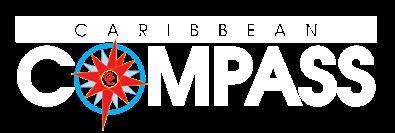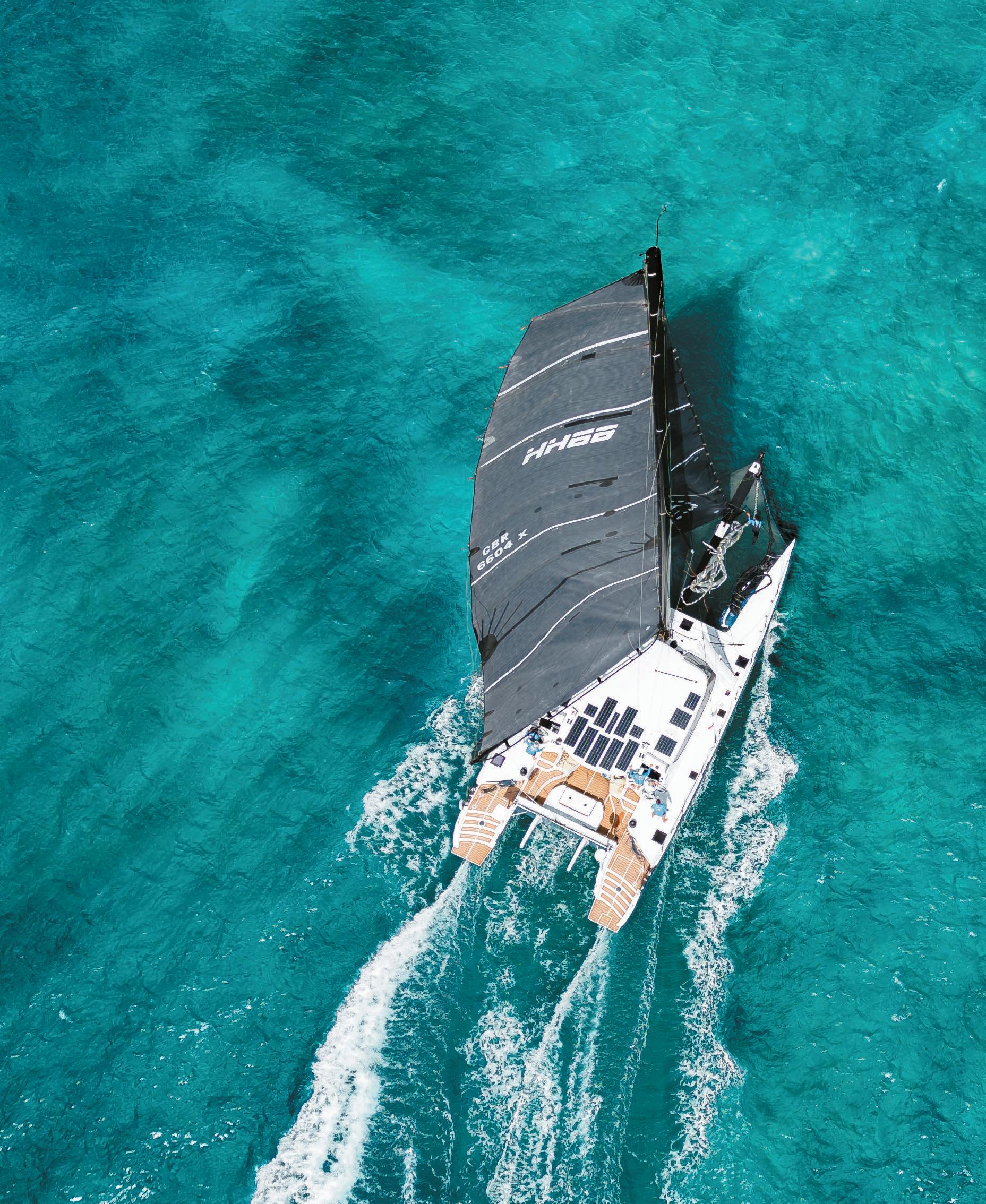


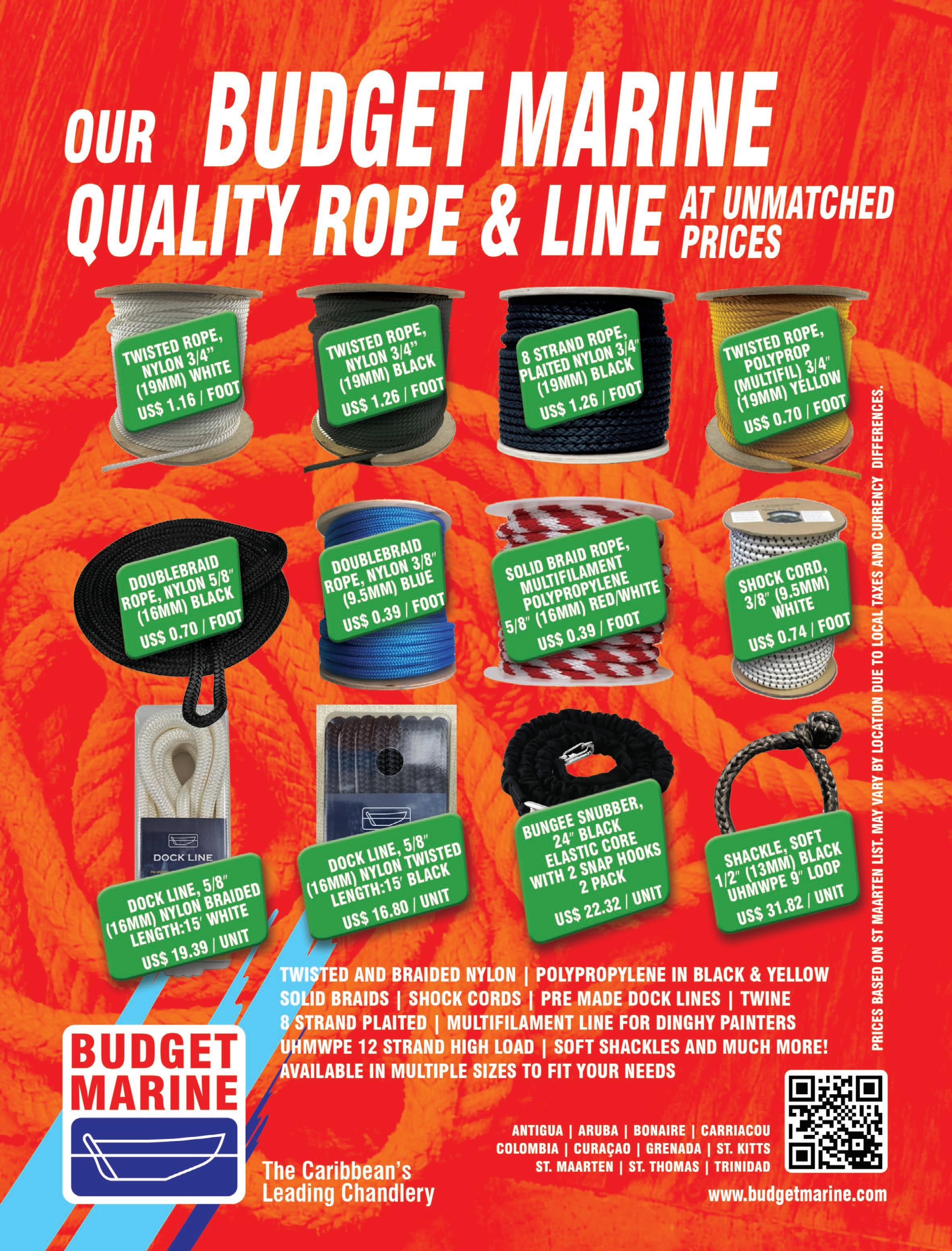
Chris Doyle
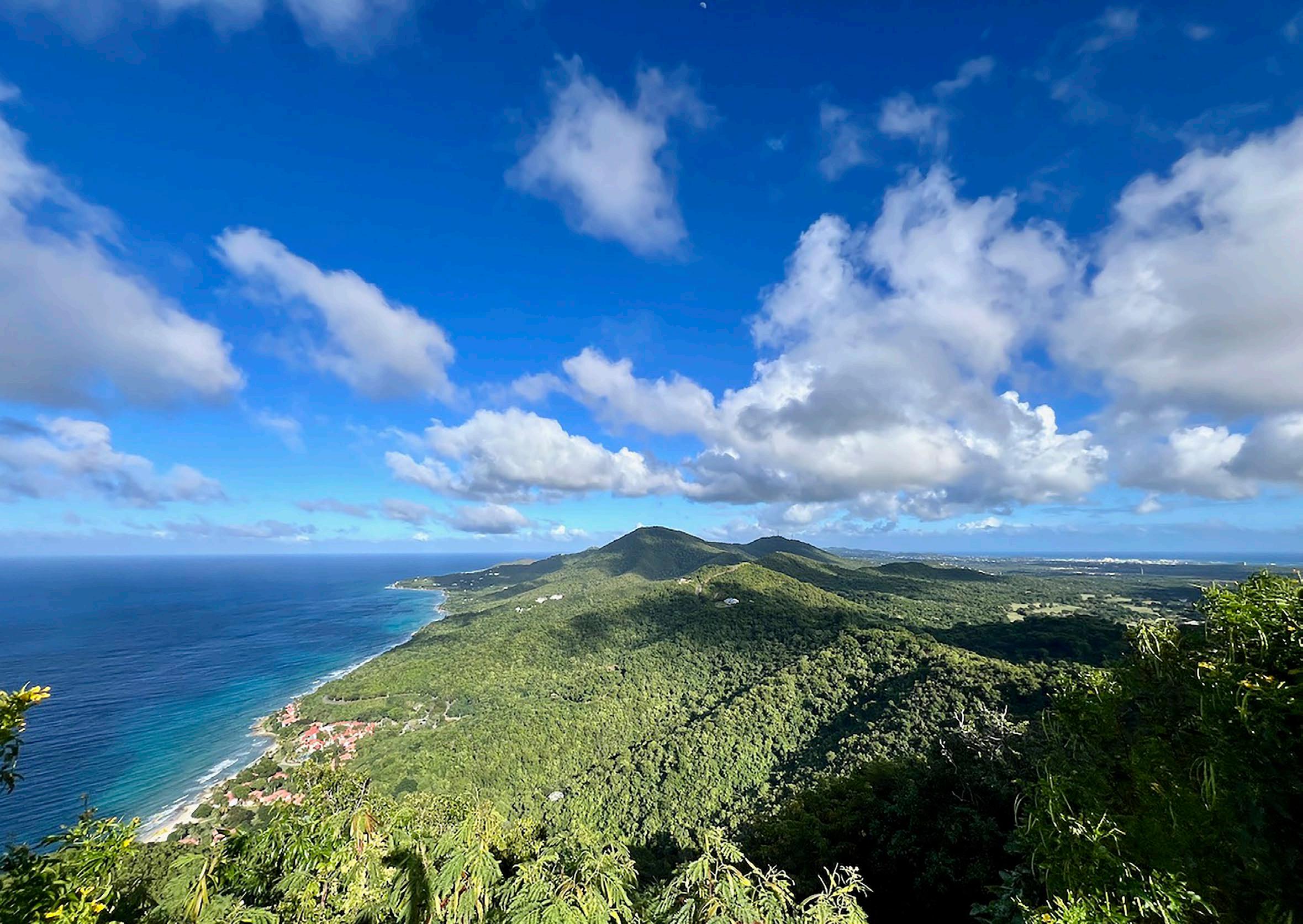





Chris Doyle

Publisher | Dan Merton dan@caribbeancompass.com
Advertising & Administration Shellese Craigg shellese@caribbeancompass.com
Publisher Emeritus | Tom Hopman
Editor Emeritus | Sally Erdle

Editor | Elaine Lembo elaine@caribbeancompass.com
Executive Editor | Tad Richards tad@caribbeancompass.com Art,
abby@berrycreativellc.com
Love the Caribbean Photo Contest 2025 Is a Hit
Through breathtaking photos and compelling stories, the Seas & Scenes: Love the Caribbean Photo Contest 2025, hosted by Caribbean Compass magazine and Environmental Protection in the Caribbean (EPIC), brought together a vibrant community whose photos and stories captured the heart and soul of the Caribbean.
In its inaugural year, the contest received 315 photo submissions from photographers across the Caribbean and beyond. Thirty-one Caribbean nations or territories were represented, highlighting a vast diversity of landscapes, both above and below the water, wildlife, and cultural settings that make the Caribbean unique and worth protecting.
The enthusiasm was just as strong for those who participated through voting, with more than 2,800 votes cast in support of their favorite photos, showing that these images and stories spoke to a broad audience about the islands’ natural beauty, biodiversity, and the rich cultural traditions that define the region.
The contest was about more than beautiful photos; it reflected the goals of EPIC and Compass to spotlight the Caribbean’s fragile environment, honor the cultures and communities, and inspire a sense of belonging and hope for the future. “The photos highlight the incredible diversity of the Caribbean. Looking at them, I felt as though I could be a tourist in my own country — each image beautifully unique in its own way,” said contest judge Irtha Daniel, House of Vetiver manager with IAMovement.
A panel of distinguished judges with experience in the arts, photography, and the Caribbean region, began the challenging task of reviewing the photo submissions in September. In addition to evaluating technical quality and creativity, they also considered the stories and
how they connected to the themes of Caribbean Nature and the People who Love It, and Yachting and Sailing Adventures.
“Reading the stories has been the best part of the contest,” said EPIC Director Tabitha Stadler. “Nearly everyone talked about those perfect days, spent outdoors with family and friends, experiencing joy, wonder, or peace. These are the all-too-rare but essential human emotions that keep us connected to each other and the natural world … and they also give us hope.” Top winners of the 2025 contest will be announced in the November issue of Caribbean Compass, with runners-up and special awards shared online in October.
Thanks go to everyone who participated, including photographers, judges, voters, and supporters, for making the first Seas & Scenes: Love the Caribbean Photo Contest 2025 a great success. Special thanks go to presenting sponsor IGY Marinas, and supporter sponsor Horizon Yachts International. Their partnerships helped make this celebration possible.
Visit the photo gallery at epicislands.org/photo-contest-2025/ and click on the “Vote Here” tab.

The U.S. Virgin Islands Department of Tourism announces Jennifer Matarangas-King as the next commissioner of tourism. A native of St. Croix, Matarangas-King brings over 30 years of experience in communications, public affairs, and leadership across public and private sectors. Her deep understanding of Virgin Islands culture and commitment to service align with the department’s goals of responsible growth and global brand expansion.
Under outgoing Commissioner Joseph Boschulte, the department led the Caribbean in Average Daily Rate (ADR), welcomed record-breaking arrivals, and launched award-winning campaigns. His tenure marked a transformative era of economic recovery and increased visitor spending.

St. Lucia Retains Team Boxing Crown
The 2025 OECS Boxing Championship concluded in August 2025 at the Rodney Bay Pavilion in St. Lucia, with St. Lucia retaining the team champion title. Now in its second year, the championship featured youth, junior, and elite athletes from across the Eastern Caribbean. Over three days, athletes competed in multiple bouts, representing their nations in a regional showcase of boxing talent.
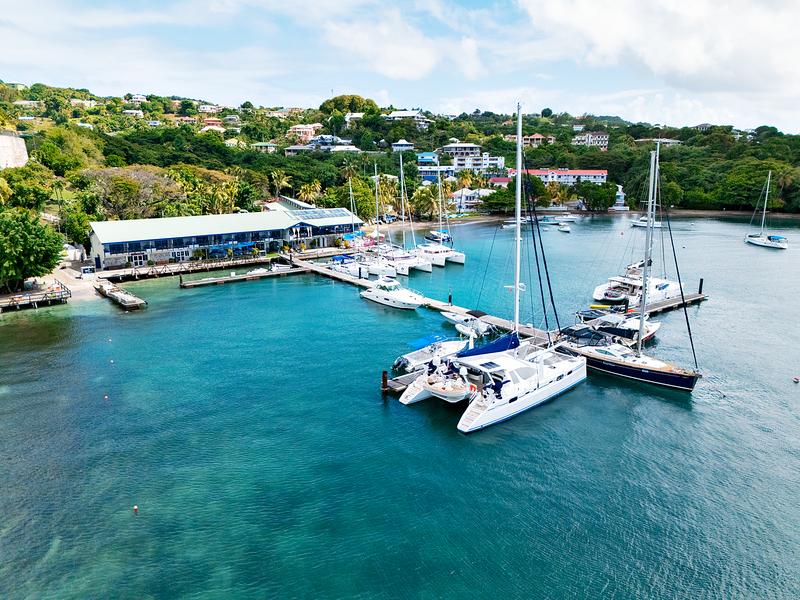



—Continued on the next page

—Continued from the previous page
The French Embassy contributed a $15,000 grant to support the St. Lucia Boxing Association, aligning with its regional cooperation priorities. The OECS Commission emphasized the championship’s role in advancing regional unity and youth engagement through sport. The St. Lucia Boxing Association, led by President David “Shakes” Christopher, hosted the event as part of its ongoing efforts to promote boxing in the territory.
The British Virgin Islands will host the 13th annual Anegada Lobster Festival 2025 from November 28–30, marking the finale of this year’s BVI Food Fete. Organized by the BVI Tourist Board & Film Commission in partnership with the Anegada community, the festival highlights the island’s culinary, cultural, and natural offerings.
Nine local restaurants have confirmed participation. The event features a culinary crawl format, encouraging attendees to explore the island while sampling lobster dishes and visiting key attractions. Anegada’s flat terrain and 13 square miles of natural beauty provide an ideal setting.


For updates and travel information, visit BVIFOODFETE.COM or follow the BVI Tourist Board & Film Commission and BVI Food Fete on social media.
The Honourable Mark Brantley, premier of Nevis, made his first official visit to Oak Bluffs, Martha’s Vineyard, in August 2025. Hosted by Nevis Diversity Ambassador Candi Carter and longtime residents Bill and Terri Borden, the exclusive event welcomed VIPs including Sunny Hostin, co-host of ABC’s The View, and Lynn Whitfield, Emmy Award-winning actress-producer. The gathering celebrated cultural ties between Nevis and the Vineyard.
Brantley invited U.S. communities to rediscover Nevis — a lush, historic island known for its welcoming spirit and as the birthplace of Alexander Hamilton. He also outlined new initiatives in real estate, sustainable energy, and tourism, positioning Nevis as both a cultural haven and investment opportunity. The evening underscored a growing bridge between Caribbean legacy and American tradition.
—Continued on the next page

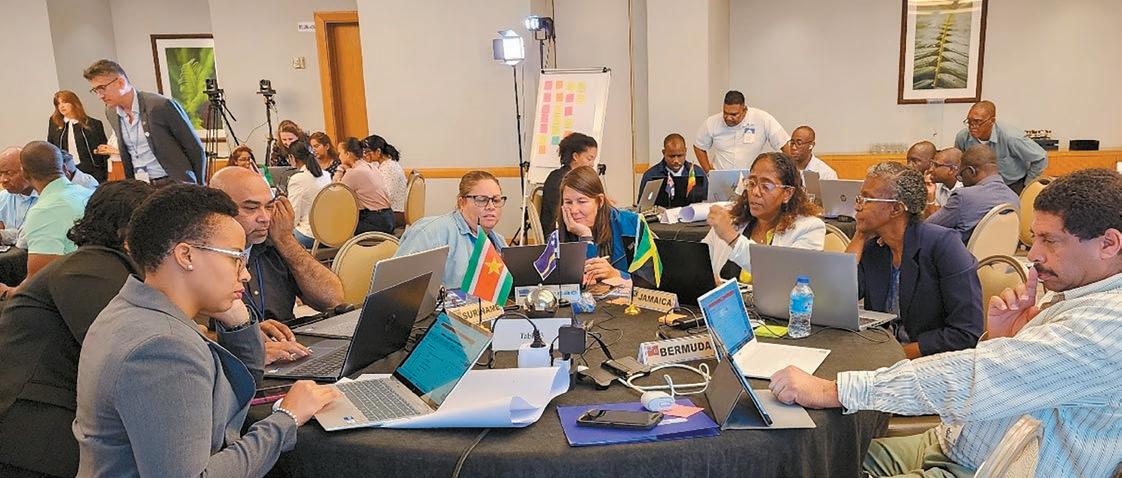
—Continued
Hope Fleet Launches Operation Rio Dulce
Hope Fleet is expanding its humanitarian mission with the launch of Operation Rio Dulce, coordinating volunteer vessels to deliver aid to Guatemala. Hope Fleet’s Ocean Reach division — made up of volunteer cruisers — can begin transporting school supplies, hygiene kits, and food to organizations such as Casa Guatemala, a children’s home, and Feeding Faith, a community outreach program.
A pilot run was successfully completed earlier this year thanks to the Cooksey family aboard S/V Dream Lover, which helped establish logistics and procedures. Now, Hope Fleet is inviting additional vessels departing from Florida to join Operation Rio Dulce. Get Involved
• Join Ocean Reach – Hope Fleet connects cruisers with organized volunteer opportunities.
• Schedule a Load-Up – For vessels departing from Florida.
• Receive Supplies & Documentation – Hope Fleet’s crew will load vessels and provide all necessary paperwork.
Sail with Support – A coordinator stays in touch until supplies are safely delivered to the partners in Guatemala. Support Operation Rio Dulce
• Make a Financial Contribution – Give at hopefleet.org/give
• Donate Supply Kits – Contribute hygiene kits, school backpacks, and other items specifically requested by our partners. Details at hopefleet. org/kits
• Transport Supplies – Learn more at hopefleet.org/ocean-reach
For more information on this operation visit hopefleet.org/rio-dulce
JN Money Expands Remittance Services
JN Money Services has expanded its remittance services to 10 new countries including Nicaragua and Honduras, strengthening financial connections for migrants, so that they can contribute to the welfare of their families in their respective home countries. The expansion is
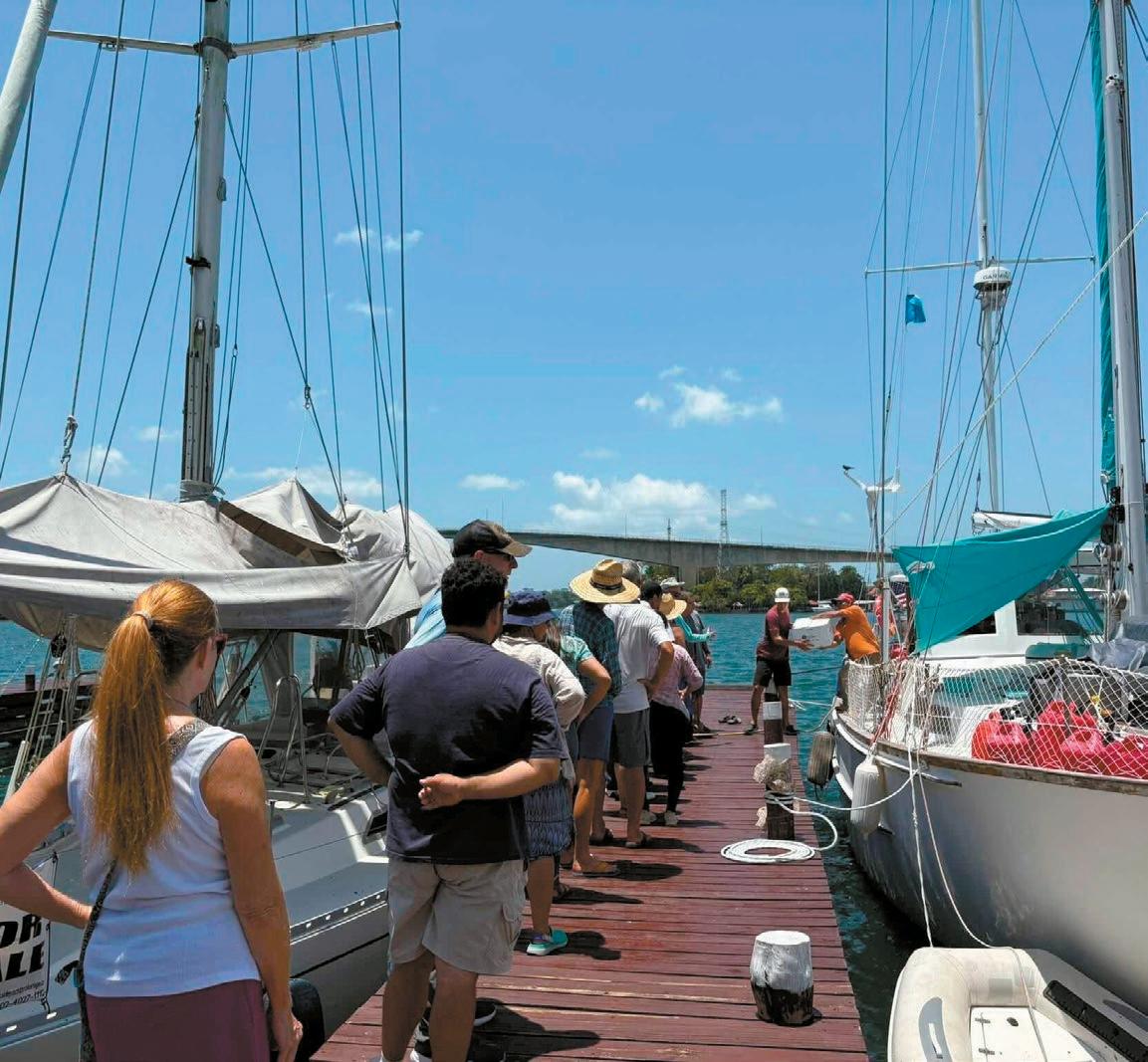
Loading a vessel full of Hope
powered by a partnership with Mastercard Transaction Services. Customers in the UK, US, Canada, and Cayman Islands can now send funds to recipients in these new countries through physical partner outlets. The company plans to continue expanding in the U.S., with new locations set to open in additional states in 2025.
For information contact Anthony Morgan of the Jamaica National Group (amorgan@jngroup.com; www.jngroup.com).
—Continued on the next page


The Nature Conservancy’s Caribbean Division, in partnership with the Reef Resilience Network, hosted a four-day marine protected areas (MPAs) workshop in August in Jamaica. Representatives from Cuba, the Dominican Republic, Haiti, Jamaica and the U.S. Virgin Islands, discussed conservation strategies, including management of Marine Protected Areas (MPAs) and theories of change for the MPAs. They created targeted action plans to boost outcomes for coral reefs and coastal communities.
By the last day, each team crafted a plan to use monitoring data more effectively, integrate adaptive management into their daily operations, and do a better job of managing their MPAs.
As climate change continues to threaten marine ecosystems, this kind of cross-sector exchange helps ensure that the Caribbean’s protected areas can achieve the protection of biodiversity, support local livelihoods, and build resilience for future generations.

Some 81 percent of vacationers say trying local foods and cuisines is the part of travel they look forward to the most, according to American Express Travel's 2023 Global Travel Trends Report. Cuisine is a key theme at the 2025 USVI Charter Yacht Show, set for November 7-10 at IGY's Yacht Haven Grande.
On November 8, USVI Celebrity Chef and Olympic Boxer Julius Jackson will host a contest with the theme, “Culinary Nostalgia: A Taste of Memories.” Participating chefs will embark on a journey through time, drawing inspiration from their childhood, cultural heritage, or significant moments from the past to recreate dishes that evoke a sense of nostalgia. The challenge will be to blend comforting, traditional flavors with modern culinary techniques, creating two courses that tell a story and bring a piece of the past to life. Judging is based on execution, appearance, taste, creativity, and color.
For more information about the USVI Charter Yacht Show, visit usviyachtshow.org
The Nevis Tourism Authority (NTA) has appointed Andia Ravariere as its new CEO, effective September 1, 2025. Ravariere brings over a decade of experience in sustainable tourism development and destination marketing across the Caribbean. She joins NTA after serving in various roles, including destination marketing manager for Discover Dominica Authority, where she achieved a record increase in visitors.

Andoa Ravariere brings over a decade of experience in sustainable tourism development and destination marketing to Nevis.
Ravariere's passion for sustainable, community-driven tourism aligns with NTA's vision. Her approach focuses on differentiation and collaboration, positioning Nevis to stand out in the global marketplace. "My vision is to position Nevis at the forefront of Caribbean tourism by strategically redefining luxury through nature, culture, sustainability, and innovation," she says.
Ravariere holds a master's and bachelor's degree in tourism development and management and international tourism management from the University of the West Indies.

The Caribbean Pet, by Kathleen Gallagher, offers sailors and travelers a comprehensive digital resource for bringing their pets to the Caribbean. With more than 20 years experience assisting pet owners, Gallagher is compiling her knowledge into an accessible guide that simplifies the process of traveling with your pets by air or sea. The Caribbean Pet Guide provides the essential information needed to navigate island entry requirements with confidence and will be available only on the Doyle Guides mobile app.
Scrub Island Resort, Spa & Marina announces the appointment of Dr. Arun Kumar Devarajan as spa manager of the award-winning Ixora Spa in the British Virgin Islands. Devarajan brings nearly two decades of global spa and hospitality experience, including his most recent role at Rosewood Little Dix Bay on the nearby island of Virgin Gorda.
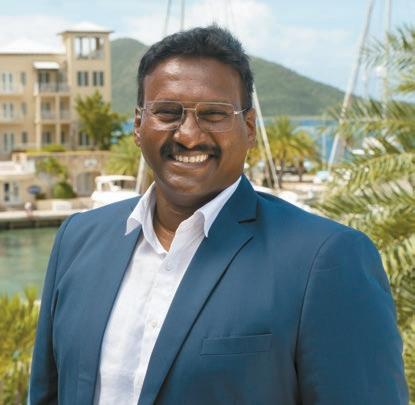
Dr. Arun Kumar Devarajan is the new manager of Ixora Spa at Scrub Island Resort, Spa & Marina, an internationally recognized wellness center.
Known for his holistic philosophy, Dr. Arun focuses on personalized treatments, attentive service, and a signature holistic approach to wellness through deep relaxation, yoga, and rejuvenation. His leadership reflects Scrub Island’s commitment to wellness innovation. To learn more, visit ScrubIsland.com or call (877) 890-7444.
Trinidad Planning Minister Kennedy Swaratsingh praised carnival and other local cultural events but emphasised the urgent need to address pressing environmental and public health issues.
He also called for greater support for local designers, artisans, and entrepreneurs by promoting the use of sustainable materials, reversing supply chains, and adopting circular business models. He made the remarks while delivering the feature address at the launch of the Global Environmental Facility (GEF) Project ID 11176, titled “Elimination of Hazardous Chemicals from Supply Chains Integrated Programme in Trinidad and Tobago.”
Speakers at the event agreed on the need for healthier communities, a cleaner carnival, job creation through green innovation, increased public awareness and education, enhanced cultural sustainability, and expanded international recognition and economic opportunity.
Project outcomes include the reduction of over 1,000 tons of contaminated costume materials and the expected avoidance of 134,000 tons of greenhouse gas emissions through improved material sourcing and reduced transportation. A code of practice for sustainable sourcing is also set to be developed and adopted both locally and internationally.
The initiative further emphasizes gender-responsive and inclusive business models, with a focus on supporting women entrepreneurs in the fashion industry.
Knowledge products and tools

“An urgent environmental and health issue that we aim to address: the environmental impact hidden behind the vibrant colors and creativity of our carnival costumes.”

developed under the project will be shared with other carnivals globally to scale up the impact.
Swaratsingh said: “Carnival is more than just a celebration. It is a symbol of our cultural identity, a major economic engine, and a global brand. Yet, behind the feathers, sequins and vibrancy, lies an urgent environmental and health issue that we aim to address: the environmental impact hidden behind the vibrant colours and creativity of our carnival costumes, while we transform a beloved cultural tradition into a global model for sustainability, innovation, as well as responsible celebration.”
He added: “This initiative will reduce hazardous chemical exposure, divert costume waste from landfills, in addition to promoting a greener, healthier carnival for all. It aligns economic opportunity with environmental responsibility, being precisely the kind of smart development this government is proud to support.”
He also said: “This project strongly supports the policy prescriptions of the state which calls for a transformed and revitalized economic agenda bolstered by serious environmental action and prescriptions, the likes of this project. This GEF 11176 project, as it’s coded, represents a bold, necessary step forward in tackling a hidden but significant challenge: the presence of hazardous chemicals within the supply chains of the world-famous carnival industry.”
Reprinted from an article by Michelle Loubon in Trinidad Express.
The Nature Conservancy’s (TNC) Caribbean Division and the Caribbean Broadcasting Union (CBU) have announced their 2025 Caribbean Media Awards for Environmental Journalism.
The Award for Excellence in Reporting on Mangrove and Seagrass Beds was presented to the RJR/GLEANER Communications Group in Jamaica for its Television Jamaica feature “Rocking the Boat” by Romardo Lyons, Ivan Shaw, and Uton West. The Award for Excellence in Reporting on Coral Reefs went to Esther Jones of the Barbados Government Information Service for the video story “Our Fragments of Hope,” which highlighted coral restoration work in Belize. Greater Belize Media (Channel 5) received an honorable mention for the story “Belize’s Reefs Improving but Still Need Saving,” produced by Marion Ali and Darrel Moguel.
St. Croix Land Acquisition Supports Conservation Initiatives
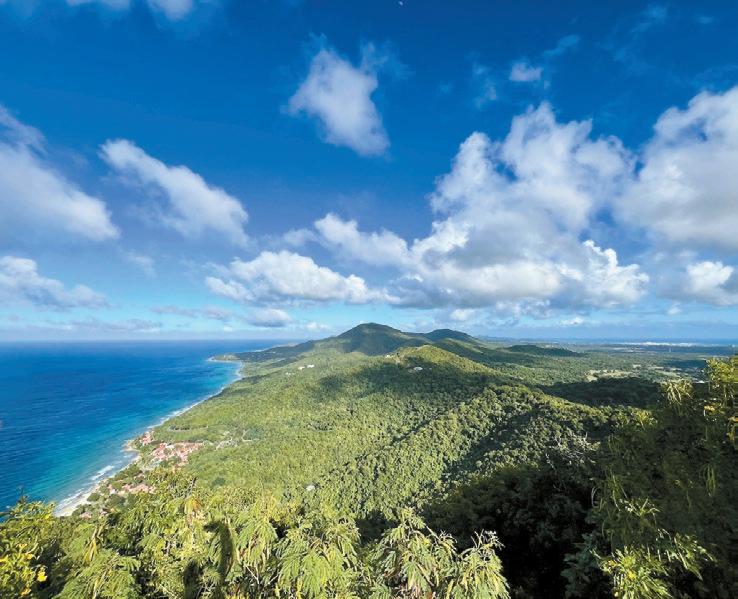
Gov. Albert Bryan Jr. and the Virgin Islands Department of Planning and Natural Resources (DPNR) have acquired 2,469 acres at Maroon Ridge and Annaly Bay on St. Croix. Finalized in August for $69 million, the purchase was funded through the U.S. Department of Commerce and NOAA under the Inflation Reduction Act. The land will be added to the territorial parks system and managed by DPNR’s Division of Territorial Parks and Protected Areas.
The acquisition was made under Legislative Act 8609, which guides the government in identifying and conserving sites of historical and cultural significance. Officials described the purchase as a collaborative effort involving federal agencies, territorial leadership, and nonprofit partners.
The Trust for Public Land (TPL) played a role in the transaction, working with the Bryan administration and NOAA to secure the property. TPL is a national nonprofit focused on expanding public access to outdoor spaces and has supported land protection projects across the U.S. since 1972.
This acquisition adds a large tract of coastal and inland terrain to the territory’s protected lands and is expected to support future conservation planning and public access initiatives on St. Croix.
By Zoë Carlton
The crowds have dispersed, the sails are furled, and the marinas are quiet again — Antigua Sailing Week (ASW) has wrapped up for another year. And it’s time to set the record straight.
Criticism over declining participation at ASW — 53 boats in 2025 — misses the broader picture. Yes, numbers are down from its golden era of over 150 entries. This isn’t just an Antigua problem. There are no regattas with these halcyon numbers now; it is a reflection of challenges facing sailing worldwide.
The Caribbean Sailing Association (CSA) hosts an annual conference that serves as a crucial forum for assessing the health of the region’s sailing industry. It brings together regatta organizers, race officials, and measurers to share best practices and chart a course forward. A recent CSA study confirmed what insiders have long known: racing participation is down across the region. In 2006, around 820 boats raced in seven Caribbean regattas. By 2025, that number has dropped to about 527 — spread over twice as many events. That’s a tighter race for entries.
As Cayley Smit, director of the BVI Spring Regatta, puts it: “The numbers of boats have definitely decreased over the long term but we are seeing a steady uptick in participation. We had a spectacular regatta this year with plenty of wind, fantastic racing and an incredible, warm vibe in the village. There are many reasons for changes in the number of boats racing in the Caribbean, but it’s not the sailing conditions — our courses are a dream for racing. We have no control over delivery costs, stacked racing calendars, or flight prices, but we will consistently deliver a quality regatta. Our BVI community works together to continuously improve on our delivery, professional race management, ease of travel, and engaging strong partners who care about sailing.”
Her comments echo the reality across the Caribbean: regatta organisers are fighting global economic and logistical headwinds, but they remain committed to delivering world-class racing experiences.
Multitude of Factors
Once, sailors could hop among three or four Caribbean regattas in a season. Now, tighter budgets, rising climate awareness, and a packed global sailing calendar force hard choices. Take Les Voiles de St. Barth — cancelled in both 2024 and 2025 due to sponsorship gaps. The Heineken Regatta in St. Maarten drew around 80 boats. Grenada hosted 30–40. Barbados? Just 15–20.
In the early days of Caribbean regattas, most boats stayed local — crews lived aboard, anchored out, and raced with less concern for weight or logistics. Fast forward to today, and it’s a different fleet entirely. Top racing yachts now transit the Atlantic on ship decks to chase both the Caribbean winter and European summer circuits. That means timing is tight — late-season events like ASW face real pressure as boats rush to cross back. Add to that the modern demand for dock access and shore accommodations, and infrastructure becomes a deciding factor.
While the boats themselves are faster and more technical, the culture of competitive sailing has shifted. Race campaigns are more performancedriven, logistically complex, and crew-dependent than ever before. A generation ago, many competitors would happily sleep on deck, pack their own food, and compete with basic gear. Today, expectations lean toward airconditioned shore digs, dockside access, professional crew, and dedicated support teams. This shift has placed logistical and financial pressure on regattas — and especially those like ASW that fall late in the season.
Antiguan businessman Robbie Ferron, who has been sailing in ASW for many years, points out that a review of Caribbean regattas shows there are no events hosting 150 boats anymore. Antigua, he says, “remains the region’s leader, but like others, it has adapted to shifting trends.”
Today’s regattas are increasingly specialised, and Antigua reflects that with a trio of events: the Classic Yacht Regatta, the long-distance RORC Caribbean 600, and the inshore-focused ASW. The Superyacht Challenge also attracts international boats. The old model of a large, mixed-fleet regatta — once the foundation of ASW’s 150-boat heyday — has largely disappeared. Adds Ferron, “The time slot held by ASW to date has eliminated the chance of entries by a

With a few exceptions, regatta participation is down across the islands, and though organizers are fighting global economic and logistical headwinds, they remain committed to delivering world-class racing experiences.
class of boat that requires to return to the UK or Europe earlier than would be possible when entering ASW. [None of this] is caused by the present management of ASW.”
Timing is indeed critical. For years, organisers have suggested moving ASW earlier to catch the RORC boats and racers still on the island. By the end of April, many yachts have already left for Europe or the U.S. to qualify for major summer events like Fastnet or Newport–Bermuda. ASW President Alison SlyAdams believes this timing challenge is the single biggest factor driving numbers down.
Meanwhile, as the yachting community shifts toward more cruisers and fewer pure racers, ASW has begun experimenting. A new “fun regatta” and pursuit-style cruising events were added in 2025 along with an early new event to focus on the race campaigns heading out early. While still in the early stages, the strong feedback shows clear potential — proof that ASW is embracing innovation and ready to grow.
Despite the regional decline, Antigua — small but mighty — hosts four major international regattas. Compare that to most Caribbean islands, which typically host just one.
Antigua, as tourism minister Charles Fernandez notes, is the “Mecca of sailing.” Sly-Adams puts it even more simply: “Antigua has always been the heart of Caribbean yachting.”
Antigua’s share of the Caribbean’s total racing entries has grown — from 31 percent to 39 percent over the past two decades. That’s not just resilience; that’s leadership.
Antigua offers robust shore and on-water support. The Antigua and Barbuda Search and Rescue (ABSAR) team, along with local divers, ensures safety and assistance during the regatta. This comprehensive support contributes to Antigua’s reputation as a premier sailing venue.
Antigua is not solely about international racing. As well as those who just come to enjoy Antigua itself, the island hosts events like the Salty Dawg Rally, the Atlantic Rally for Cruisers (ARC) boats sail-in, the Oyster World Rally and new this year, the Mini Globe Race. These events attract a mix of cruisers and racers, showcasing Antigua’s versatility in catering to different sailing communities.
Today’s sailors are different. Many now prefer high-prestige, tightly run events like the RORC 600 — faster, more intense, and easier to schedule. Ironically, the success of the Caribbean 600 has created new challenges for ASW: boats arrive for that race, leave before Sailing Week begins to race elsewhere. Notwithstanding, ASW 2025 welcomed boats from over 20 countries — and included significant Antiguan-owned participation.
Critics are quick to compare 2025’s 53 boats to 2024’s 88 and 750 crew. Despite this, dock master Tommy Patterson points out that the marinas have not seen a noticeable drop in boats over the 2025 season. This narrow view ignores the overall picture and long-term global trends: fewer racing yachts, more cruising sailors, and more curated sailing experiences.
—Continued on the next page
Behind the scenes, many local voices are also calling for deeper community inclusion in the regatta’s planning — ensuring ASW stays grounded in its roots while innovating for the future.
Local participation remains strong. While the regatta may no longer stretch to the farthest shores of Antigua, 40 young Antiguans joined visiting boats as crew this year, and around 10 Antiguan-owned boats raced in the event.
ASW is more than a regatta — it’s an economic lifeline. “We welcome the sailors — this is our last chance to boost our season,” one restaurateur said. Taxi drivers, market vendors, and hoteliers feel the lift, too. Andrew Dove of North Sails noted, “ASW always brings in more business.” Its impact radiates far beyond English Harbour.
Although the government has signalled plans to take ASW “in-house,” recognising its cultural and economic value, the event is still owned by Antigua Barbuda Hotels & Tourism Association, with a licence in place until May 2026. If executed well, more government input could better align the regatta with national tourism goals. But it must preserve the expertise, relationships, and energy built by the current ASW team.
“There’s a conversation to be had with the government about what Antigua wants ASW to be,” says Sly-Adams. “Through 2024 and right up to before 2025 ASW has engaged with stakeholders and put forth potential solutions to the issue. Clearer and unified vision, better marketing and strong collaboration are critical to the future success.”
Antigua
The Antigua Yacht Club is the cornerstone of the island’s sailing legacy. Financially constrained, yet still host to all major international regattas, its role cannot be overstated. A glimmer of progress came this year with a new three-year agreement between AYC and RORC for the Caribbean 600 — proof that solutions are possible.
To remain a true international sailing mecca, Antigua needs a yacht club equipped to meet global standards. A prolonged financial dispute with the South West Properties Marina and Resort Ltd has left the Antigua Yacht Club (AYC) unable to invest in its facilities for over six years. But make no mistake: to support Antigua’s sailing future as a world-class destination, serious investment in the AYC as a world-class yacht club is not optional.
Infrastructure:
Race
It is not just down to AYC or ASW. The wider infrastructure must support the event. In 2025, on the eve of ASW, the main road leading into the Yacht Club was dug up for repairs and simply left — prompting loud (and colourful) complaints from visiting crews. Parking in the area remains a major challenge. Moorings and jetties must be made safe and maintained before, not during, the regatta.
Cost is another challenge. A recent travel survey cited by The Daily Mail, named Antigua the second most expensive tourist destination in the world. Visiting sailors often cite the high cost of food, mooring, accommodation, and transport.
ASW still combines serious competition on the water with warmth and welcome ashore. From elite racers to curious first-timers, everyone is invited.
And Antigua is not alone in this. Across the Caribbean, from the BVI Spring Regatta to the Heineken in St. Maarten, organisers are adapting — working harder than ever to overcome delivery costs, crowded calendars, and shifting sailing cultures. This is a regional fleet facing the same winds, and in true sailor fashion, they are trimming their sails and finding a way forward.
Whatever course ASW charts next, one thing is clear: the heart of Caribbean yachting still beats strong in Antigua — and it beats in time with the whole region. This isn’t just a regatta. This is a community of islands proving, year after year, that the Caribbean is still one of the greatest places in the world to race a boat.
Zoe Carlton is a journalist and media personality in Antigua telling stories of life in the Caribbean on and off the water.





A Salty Dawg, ready to roll
The Salty Dawg Sailing Association invites offshore cruisers to join the 2025 Caribbean Rally, setting sail for Antigua from Hampton, Virginia, or Newport, Rhode Island, around November 1, with an optional stop in Bermuda, or the Bahamas. The rally is supported by professional weather routing, 24/7 medical and emergency services from GW Maritime Medical Service, and comprehensive shoreside coordination and tracking, ensuring safety and camaraderie every step of the way. Participants also enjoy pre-departure seminars, fleet tracking, social events, and US Coast Guard demonstrations, all included in the rally fee. Spots are limited once the fleet reaches capacity. Eligible boats will be waitlisted.
https://www.saltydawgsailing.org/caribbean-rally-2025
The CMC Introduces New Line Honors Award for 2026
A new trophy, the Line Honors Award, will be offered for the first time at the Caribbean Multihull Challenge VIII running from 28 January 28 to 1 February 1, 2026 in Sint Maarten. Organizers are taking another giant step on behalf of skippers who want to race and win based on flat-out speed on a specific course without regard to a handicap rating.
Three of the four days consist of longer distance racing with one of the days made up of two shorter races, making a total of five for the regatta. A recently improved handicap rating system will be used for 2026 with an award for winners based on the CSA rule; a prestigious line honors competition will be introduced, with a prize for the fastest yacht over the four days of racing.
Skippers will see a 60-mile sprint around St. Barts, a 52-mile dash to Saba and back, a 27-mile navigational challenge around the rocks and little islands of St. Maarten with one day reserved for sailing mostly on
the south shore, where the winds are strong but the wave action less. The sponsor for the Line Honors Trophy will be announced soon. Enter and register for the CMC at www.YachtScoring.com/ or at www. CaribbeanMultihullChallenge.com/ For more information contact Stephen Burzon at StephenBurzon@gmail.com
The Caribbean Sailing Association (CSA) has released its five-year calendar for Caribbean-based international regattas from 2026 to 2030. The schedule brings together professional and Corinthian sailors, onedesign fleets, race and bareboat charters, cruisers, and rallyers during the winter sailing season.
Key changes for 2026 include the BVI Spring Regatta moving to March 23–29 and the launch of the Antigua Racing Cup, set for April 9–12. Antigua Sailing Week returns in a new four-day format with point-topoint racing, cruising classes, and rally options. These adjustments allow teams to complete Caribbean campaigns by mid-April and prepare for summer regattas.
Several events, including the BVI Spring Regatta, St. Maarten Heineken Regatta, Grenada Sailing Week, St. Thomas International Regatta, and Antigua Racing Cup, will offer dual CSA/IRC scoring. One-design fleets continue to grow, with IC24s in St. Thomas, Diam 24s and Sunfast 20s in St. Maarten, and Dragons and RS Elites in Antigua.
For event details, ratings, and charter options, visit caribbean-sailing. com. To list a boat for charter, email news@caribbean-sailing.com
2026 Calendar from ABYMA
The Antigua and Barbuda Yachting and Marine Association (ABYMA) has also announced its upcoming events. The 2026 calendar includes sailing, rowing, fishing, and youth engagement programs.
—Continued on page 14
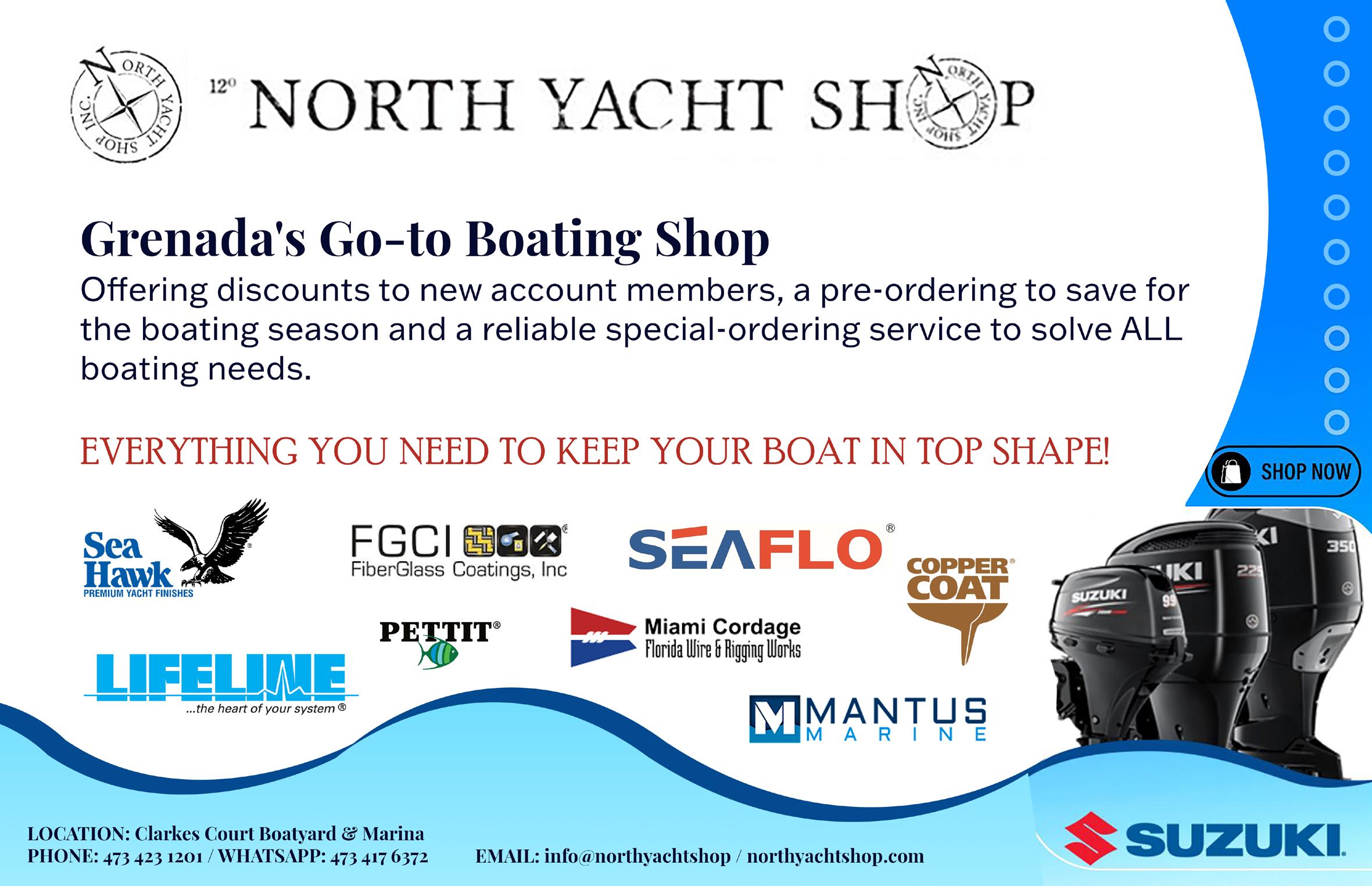


—Continued from page 11
The RORC Transatlantic Race will start January 11 from Lanzarote, arriving in Antigua. Other early-season events include the Antigua Charter Yacht Show, the Salty Dawg Rally, and the World’s Toughest Row. Major international regattas such as the RORC Caribbean 600, Antigua Superyacht Regatta, and Antigua Classic Yacht Regatta return, joined by the new Antigua Racing Cup (April 9–12). The Mini Globe Race will hold its prize-giving in March, celebrating the 19-foot boats that began their circumnavigation from Antigua.
The Antigua Yacht Club will host the RS Elite Small Keelboat Regatta in January and the Caribbean Dinghy Championships in October. Youth engagement continues with the 4th Annual Discover Yachting & Marine event (October 8–9), promoting career paths in the marine industry.
For full details, visit abyma.ag.
ARC Baltic Rally Announced for 2026
World Cruising Club has announced ARC Baltic, a new 28-day cruising rally for July 2026, open to sail and motor yachts. Covering nearly 1,000 nautical miles, the rally begins in Kiel, Germany on July 3, visits five countries, and ends in Bullandö, Sweden on July 31, offering Nordic-style mooring, island-hopping, and city sailing.
The route includes stops in Stralsund, Bornholm, Gotland, Tallinn, Helsinki, the Åland Islands, and the Stockholm archipelago, with the longest leg 200 nautical miles. The fleet is limited to 25 boats of 27–50 feet to access smaller harbors and enjoy wild anchoring. Larger yachts and multihulls may join if space allows.
Entries and info packs are available at worldcruising.com.
SVG Sailor Scarlett Hadley Succeeds at the Junior PanAm Games
Eighteen-year-old Scarlett Hadley represented St. Vincent and the Grenadines (SVG) at the Junior Pan American Games in Encarnacion, Paraguay, in August. This is the first time SVG has competed in sailing at these games.
Hadley, the third youngest competitor, finished five races against the

best young sailors from across the Americas and the Caribbean. Her best result was an 11th, finishing 15th overall. Her coach was three-time Olympian Andrew Lewis from Trinidad. “She was a dream to work with,” said Lewis. “She has yet to reach her true potential, so she has plenty of opportunities for greater success ahead.” Her goal is the Olympics, and her next big event will be the Youth World Championships in Portugal in December.
If you would like to get involved in sailing, please email svgsailingassociation@gmail.com
Sint Maarten Youth Sailors Compete Across Caribbean
The Sint Maarten Yacht Club Racing Team completed its 2024–2025 season with appearances in multiple regional regattas. At the Caribbean Dinghy Championship in October, Nathan Sheppard placed first in the Optimist class, with Harper and Adilyn Treadwell finishing seventh and 10th. Axel Vanden Eynde and his father Joris won the RS Quest fleet, while Oskar Jarrett Versteegden and Chris Meekhof led the RS Zest. Sint Maarten placed second in the Nations Cup.
The Sint Maarten Optimist Championship drew 45 sailors from nine countries. Axel placed second in the Green Fleet, Oskar second in the Benjamin Fleet, and Nathan second in the top fleet.
At Martinique’s Schoelcher Sailing Week, Sint Maarten sailors competed alongside Saint Martin Voile Pour Tous. Massimo Lapierre placed fourth in ILCA 4; Oskar placed 10th in the Optimist fleet.
The season continued with the Heineken Regatta, Curaçao Youth Championships, and Mini Bucket in St. Barts, where Sint Maarten sailors earned multiple top-five finishes across divisions.
The 15th Annual Antigua & Barbuda Hamptons Challenge Regatta held in Sag Harbor, Long Island, in August, offered the grand prize of an allexpenses-paid trip to Antigua to compete in Antigua Sailing Week 2026. The event also featured a $5,000 donation from the Antigua and Barbuda Tourism Authority to a local nonprofit that builds confidence and resilience in middle school girls through triathlon training and mentorship.
Colin C. James, CEO of the Antigua and Barbuda Tourism Authority, highlighted the event’s significance to the island’s tourism strategy: “The Hamptons Challenge not only promotes Antigua and Barbuda as a premier sailing destination but also enables us to connect directly with travelers who appreciate culture, community, and world-class experiences. It’s always a privilege to bring a piece of Antigua to the Hamptons.”
In late August 2025, the St Vincent and the Grenadines Sailing Association hosted two days of racing at the Sailing Association's High Performance Centre at Coconut Grove. With beautiful sailing conditions and steady 12-knot trade winds, 22 sailors from across St Vincent, Bequia, Mayreau, and Union Island competed for the title of SVG 2025 National Champion.
Boats in the ILCA 6, ILCA 4, and Optimist classes completed a full schedule of 12 races each. The event demonstrated the high level of talent among SVG's youth sailors, and also the growing strength of youth sailing in the country.
Results:
• ILCA 6: Kai Marks Dasent delivered a dominant performance, securing first place in eight of the 12 races to clinch the overall victory. He showed exceptional consistency and tactical skill throughout the event.
• ILCA 4: Joshua Weinhardt claimed the top spot in this fleet, finishing first in seven races to emerge as the overall champion. He demonstrated strong boat handling and race strategy throughout the competition.
• Optimist: Keyron Harris took top honors in the Optimist fleet, winning six races on his way to overall victory. He showed focus and determination across the series.
Blue Life Yacht Charters provided the committee boat. The Championships were made possible through the support of sponsors CG United, Island Sipz, KFC, Kestrel, Tradewinds, and the National Olympic Committee.
Anyone interested in sailing should email svgsailingassociation@gmail. com
In the early 1970s Grenada was quiet and tranquil. About a dozen grand old charter yachts from 50-70 feet long were in the lagoon, along with a few individually owned bareboats. One, Rustler of Arne, was mine. There were maybe 40 cruising boats owned by cruisers and locals on the island, generally in the 30-40-foot range, and six knots was considered fast.
by Chris Doyle

Most yachts were on the docks of Grenada Yacht Services (GYS), a much smaller marina than Port Louis, which now takes its place. GYS had a screw lift to haul the larger yachts, and Prickly Bay on the south coast had a railway and a small dock. Grenada Yacht Club, across the water from GYS, was the other popular yachting facility. Nowadays, if you look at the yacht club, it is sandwiched tight into St. George’s port and has a fuel dock and a good many docks for local boats. Back then, the port was smaller and did not even touch the lagoon. Grenada Yacht Club stood on a piece of land called the Spout, with a clear view across the entry passage and out to sea. We would sit on the deck with drinks in hand and watch as boats passed through the narrow channel. Occasionally, my friend Ron Smith would give me a call and offer me a blowby-blow account of Rustler when charters ran aground.
In those days the yacht club had a dock extending to sea, where a boat could come alongside, and parallel to this was a simple railway with a wooden cradle and a hand-crank winch. Those with enough energy could haul boats of 30-35 feet. Hauling was laborious, launching was trickier. The slope was insufficient to allow the boat to roll gracefully into the water. The way to launch was to let
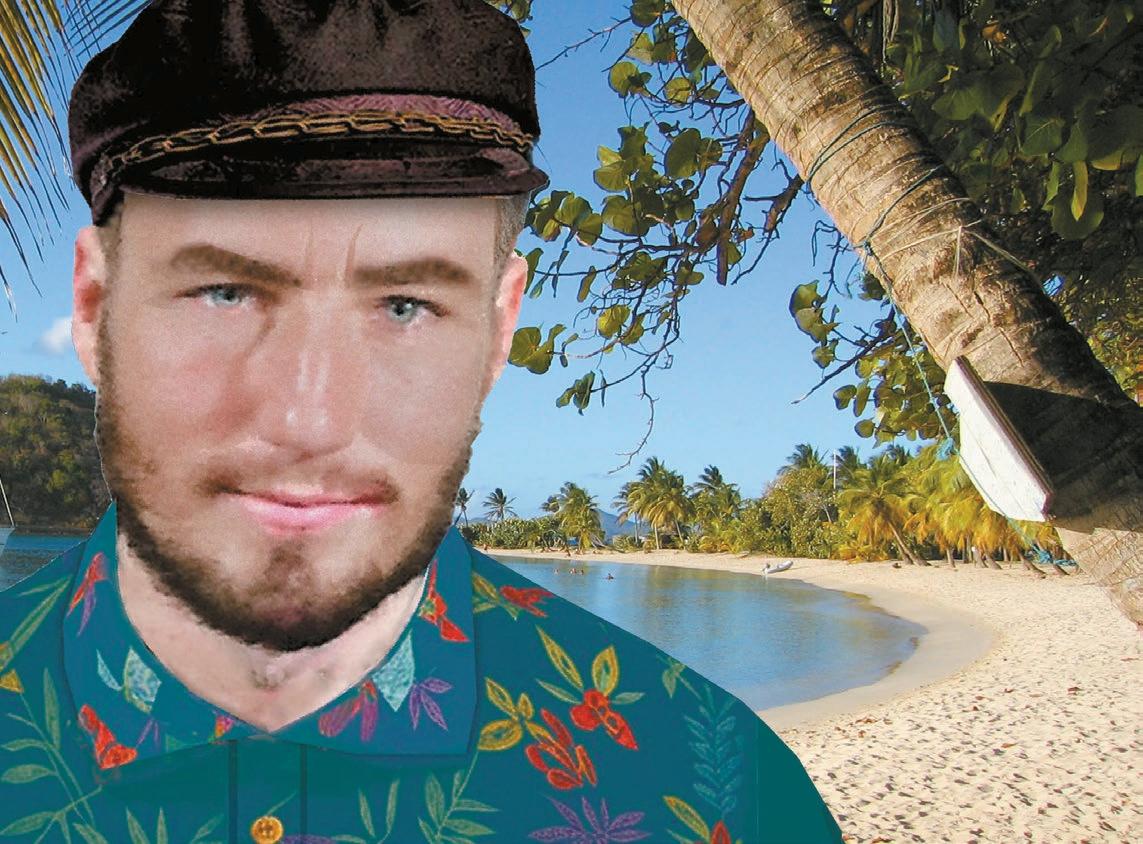
out plenty of cable so the trailer was free to roll. To get it started, you needed a few people to push hard downhill till the cradle got up enough speed to launch the boat with a giant splash.
Grenada Yacht Club was a popular meeting spot for members and cruisers, with a basic bar and restaurant. Regattas were arranged from here, as was an annual fishing tournament. Don Street was often around. He had a house on the ridge above Benje Bay and lived in Grenada much of the time. He refitted his boat Iolaire several times on the yacht club dock. I remember the first time I met him. My friend John Hazlehurst, owner of Paisano, one of the grand old charter fleet, took me to meet him by car. We rattled down this rutted road and came to a small well-worn wooden house. Beside it stood a large iron-framework rusty windmill, stationary despite the breeze. Out came a figure slim of build, wearing a large straw hat, with strands of hair showing below. He had a long scraggly full beard, ginger in color, which hid many of the buttons on his shirt but did not make it down to his jeans. He welcomed us in the high-pitched voice that earned him the nickname “Squeaky.” I thought for a moment I was somehow in Appalachia, but the palm trees said Grenada.
Don at this time was just starting to write his first cruising guide, taking his first steps to becoming a legend. Back then he was one of many people you might meet, like Ray Smith, the commodore of the yacht club, his brother Ron, head of public works, plus some colorful characters anchored below including Rabbit Man and Banana Bill. There was always someone to talk to.
When I walked into the yacht club and saw Freedom’s Child on the club jetty, it was love at first sight. She cast bright yellow reflections on the calm water and was the most outrageous looking machine I had ever seen. The main hull was 37 feet long with a beam of maybe three feet at water level, flaring to five at the deck. Some twelve feet to port she was accompanied by her outrigger, 20 feet long by two feet wide. They were joined by two crossarms which curved gracefully over the water between. The arms were lashed to the hull by miles of nylon cord. She was an open boat, save about 10 feet of decked bow and stern. She had a short Bermudan ketch rig adjusted by deadeyes, with a small jib.
Her designer and builder, Russel Hawn, a young American, was about to leave for Trinidad to take part in the annual Trinidad-Grenada race. His goal was to build a boat in the local sailing fishing-boat style inexpensively and with locally available materials and labor, but to try and jazz up the design to produce a faster and more stable craft. He hoped his design might help the local fishermen get to the fishing grounds faster and be a more stable platform for fishing. People had become somewhat skeptical of his design, since in his first race he had been forced to retire with numerous problems, his crew telling tales of uncontrollable speed and disastrous gear failure. Russel planned a comeback.
—Continued on the next page
It did not go well. Her mast step had collapsed, and she was towed. The local yacht club regulars now treated her as a joke. Russel fixed the mast step. It was then that I had my first sail in her. It was a pleasant afternoon, blowing about Force 4 with waves of 2-4 feet. I remember great speed, water everywhere, gushing up through the centerboard housing, and flying over the bow; the crew pumping continuously, and being fascinated by the outrigger which flew high on the port tack and buried itself in a mountain of spray on starboard. Unlike many proas, she didn’t end for end.
Russel left for a long time after that, and when he came back, he was on his way to the States. No one was interested in buying Freedom’s Child. Russel declared he was going to remove all his fittings and the sails, then sink the hulls. I traded him a lovely little sailing dinghy and a little cash for the hulls, mast, and rigging.
I needed help so I found two partners: Peter and Tony. Peter, a cruising dentist, worked for the government. Gregarious, fun and a regular at the yacht club bar, Peter was living ashore and missed sailing. Tony was a bearded introvert who was living on an ancient gaff-rigged smack, recognizable by the pile of spare spars and other paraphernalia which adorned her decks. He was generally barefoot and would wear strong pants and shirts until they wore out. His shyness could make him seem crabby, but when you got to know him, he was kind and a genius at fixing anything electronic or mechanical. People considered us an unlikely team to go proa sailing.
In a couple of months we had her ready. Cruisers gave us cast-off sails and we recut them in a defunct hotel. We ransacked our boats for pulleys and lines.
We sailed by anarchy. No skipper, but each did his own thing as he felt inclined. Although against nautical traditions, it worked well enough, and I only once remembered the helm being left for any period of time when no one wanted to take it. We put a 2-foot-wide net alongside the rear crossarm, so one of us could crawl out and sit on the outrigger, a suggestion that was met with derisive laughter from those who had experienced her wild ways.
—Continued on page 18






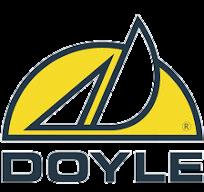








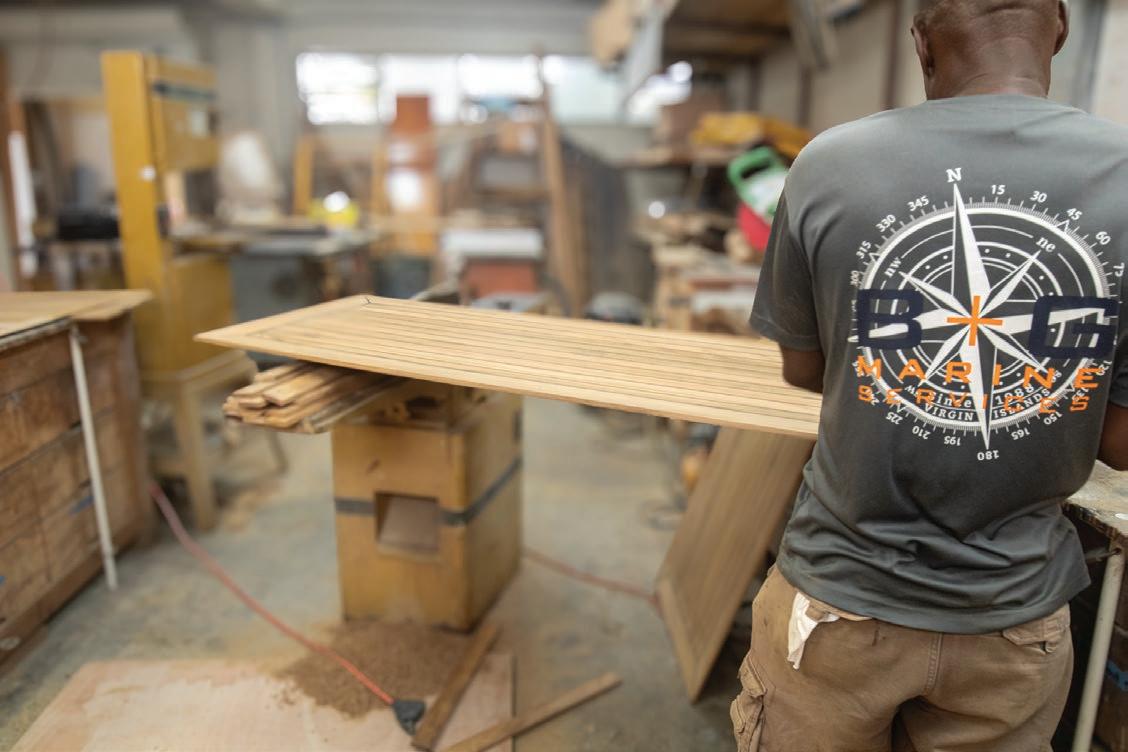







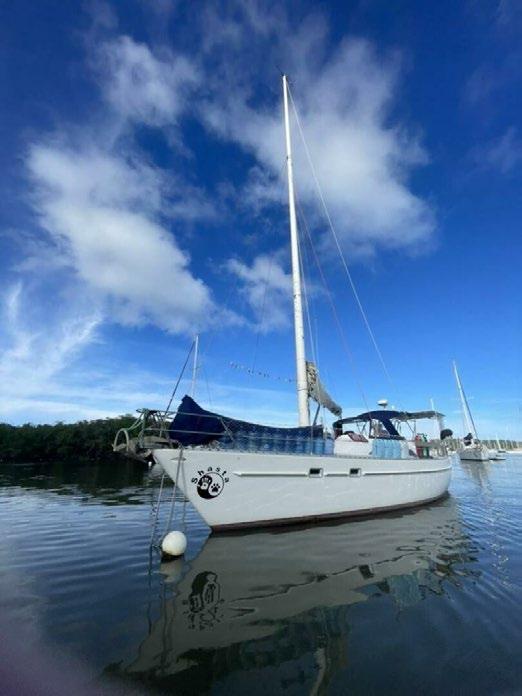
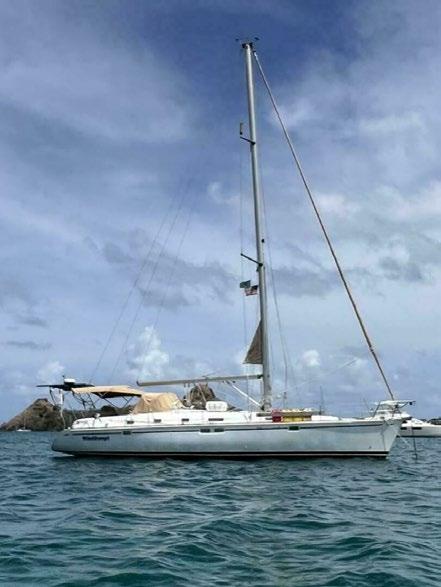





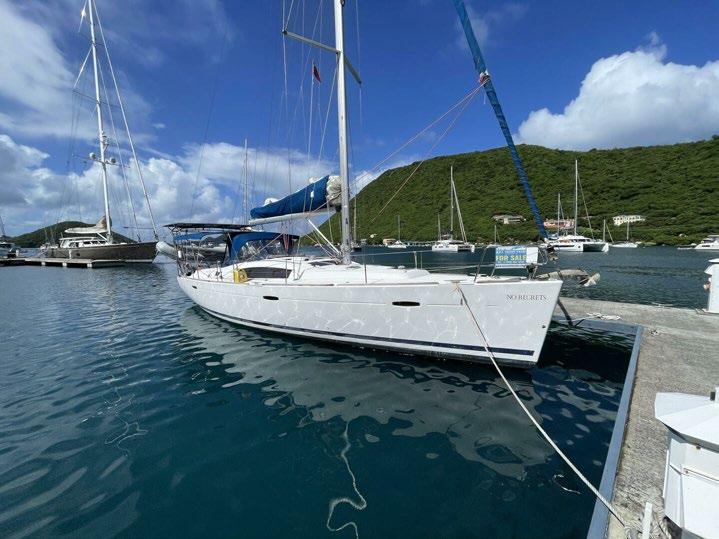

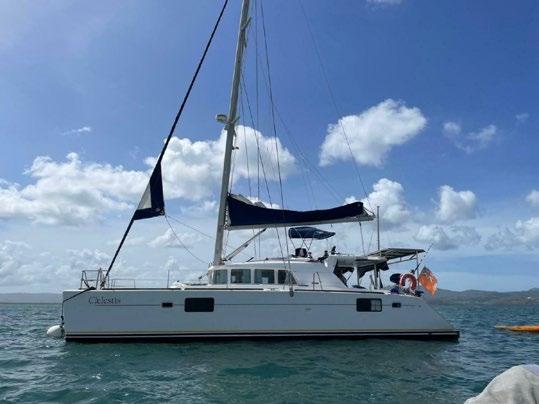

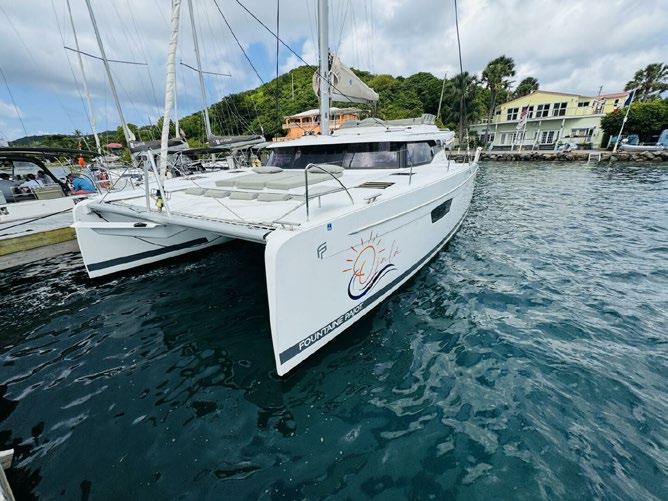





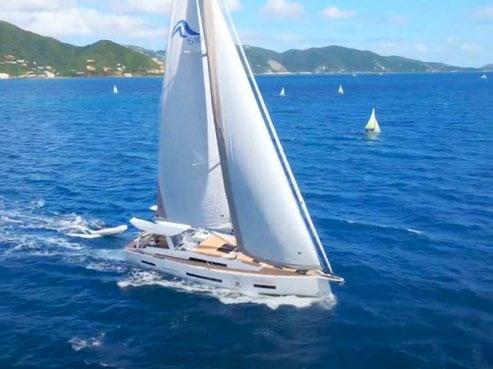




With practice it wasn’t hard and riding the outrigger became our favorite job. Out there, and away from the helmsman’s mutterings, and the continuous straining of the sheetman, whose job was to ease and tighten the main according to how high the outrigger lifted, one could sit in quiet contentment, holding on for dear life, alternately flying and submarining as if riding a giant porpoise. The trade winds blew hard that year, we took her out, never reefing. She was the wettest boat imaginable, cutting remorselessly through every sea. Bailing with a bucket was continuous, but the feeling was wonderful.
Our first big weekend was Whitsun for St. Vincent’s ‘Round Bequia Regatta. The yacht club pundits maintained we surely wouldn’t make it, and did we have life insurance?
St Vincent is 80 miles on starboard tack from St George’s, with a string of islands between. We decided to spend the night halfway at Union. By midafternoon we were going well, clear to the north of Grenada, in a force 3-4 accompanied by a gentle sea. As we progressed it became apparent that the outrigger, which tended to submarine a little on the starboard tack, looked about ready to deep-six itself for good. I opened my mouth first and found I’d automatically volunteered for the job of crawling out there for a look, while the others tacked the boat to lift it a little.
The outrigger had filled up and bailing was impossible at sea as waves were continuously washing over it. We ran back to Grenada on port tack and found

a little cove to anchor in. Our first problem was to get the outrigger high enough so that we could bail without the swell washing over and filling it again. So we swung the boom out opposite the outrigger and while Peter and Tony sat on the boom having a smoke, I bailed. By the time it was fixed we would be sailing in the dark — not a pleasant prospect as the breeze had freshened and we had to pass the notoriously rough Kick ‘em Jenny Rock to get to Union.
It turned out to be a magnificent sail.
Freedom’s Child flew through the night almost leaping from wave to wave, blazing a trail of phosphorescence. When the strong gusts hit, she would pause a little; then everything took up in a frightening chorus of creaks and groans, and she would leap forward with an acceleration that could lay the unwary flat on their back.
The next day we reached St. Vincent in a confident mood. At the race meeting we looked at our handicap and noted with pleasure we were not the scratch boat. However, the rest of the Grenada contingent, scarcely believing we had actually arrived, formed a pressure group, and our handicap was uplifted to top of the list. If we were not popular among the yachtsmen, the kids loved us.
“You in de two piece?” they would call, “I bet a dollar you win.”
Look for Part Two of “Freedom's Child” in an upcoming issue of Caribbean Compass.

Editor’s note: A familiar problem to those who spend time aboard seagoing boats was addressed in the October Caribbean Compass more than a decade ago by two legends. Thanks again to Chris Doyle and the late Don Street. Happy sailing to you both, one on the blue waters of the Caribbean and the other on that vast, far-off ocean and that distant port to which the only customs and immigration declaration is a life well lived.
Steering loss all too often results in abandoning ship. Under some circumstances, this is perhaps the wisest course of action. But at other times, the ability to use an emergency tiller, replace a broken steering cable, or steer using the sails and/or a drogue, can result in a successfully completed passage.
The inadequacy of many emergency tillers was brought home to me early in my career as a delivery skipper.
By Don Street
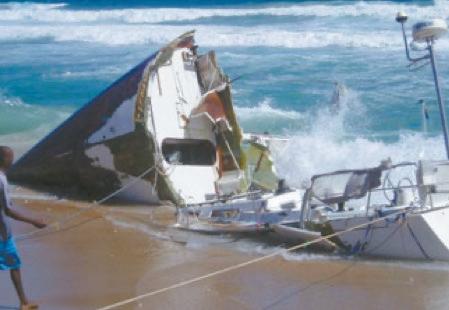
I was delivering a 40-foot sloop with a short keel but attached rudder from Grenada to Ft. Lauderdale, Florida, via St. Thomas. About 50 miles west of San

Juan, Puerto Rico, the hydraulic steering system packed up. We installed the emergency tiller but it was neither well designed nor strong and collapsed after about five hours. I discovered that the biggest socket in the socket wrench set would fit on the rudder head. A tackle on the wrench handle led to a winch which gave us enough control to sail her 400 miles to San Salvador in the Bahamas, where we stopped and rebuilt the emergency tiller.
Atlantica, a 46-foot, Stevens-designed gaff-rigged schooner, also had an emergency tiller which, we discovered when we tested it, was really useless. The lever arm was only three feet long and, typical of gaff-rigged schooners, on a reach (because of the gaff falling off as sheets are eased), Atlantica had heavy weather helm. An hour on the helm and the helmsman’s arms had been stretched so much he looked like an orangutan. The emergency tiller was made out of pipe, so we made a wooden extension that fitted into the end to create an eight-foot lever arm.
—Continued on the next page
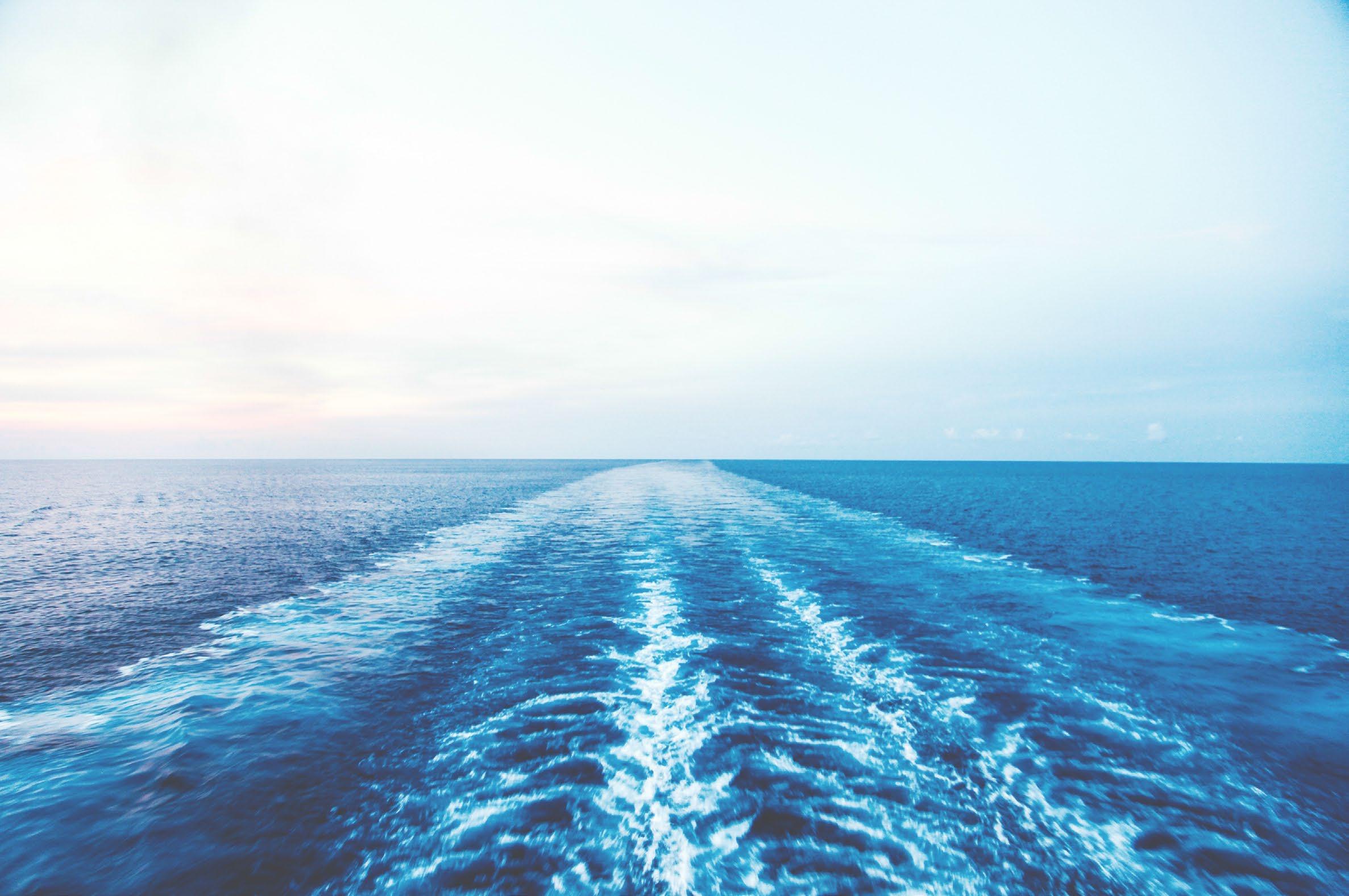



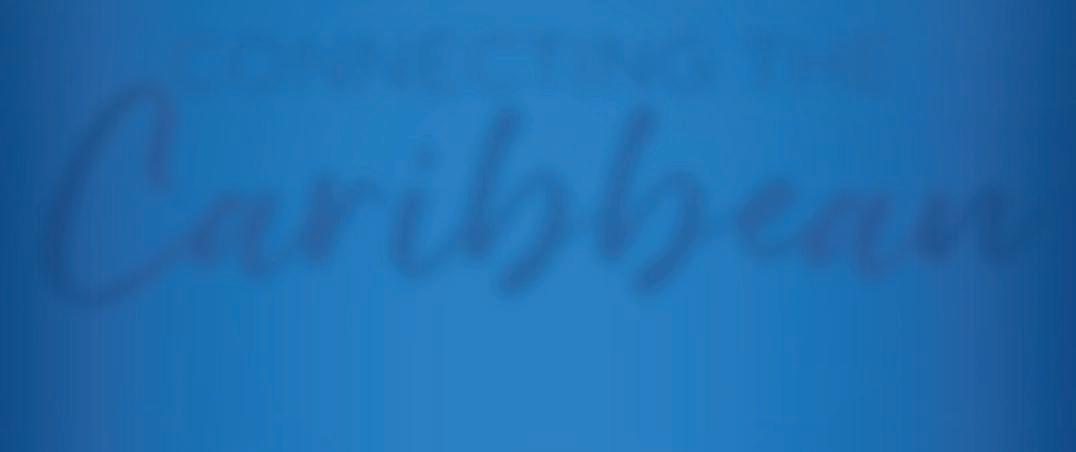



Whether you're traveling for business or chasing the sun, Cape Air makes island-hopping easier than ever.
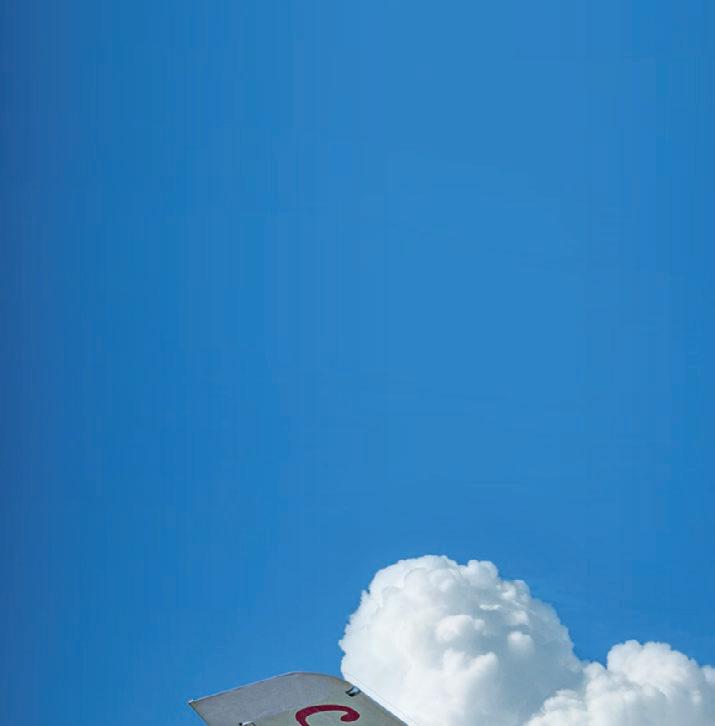

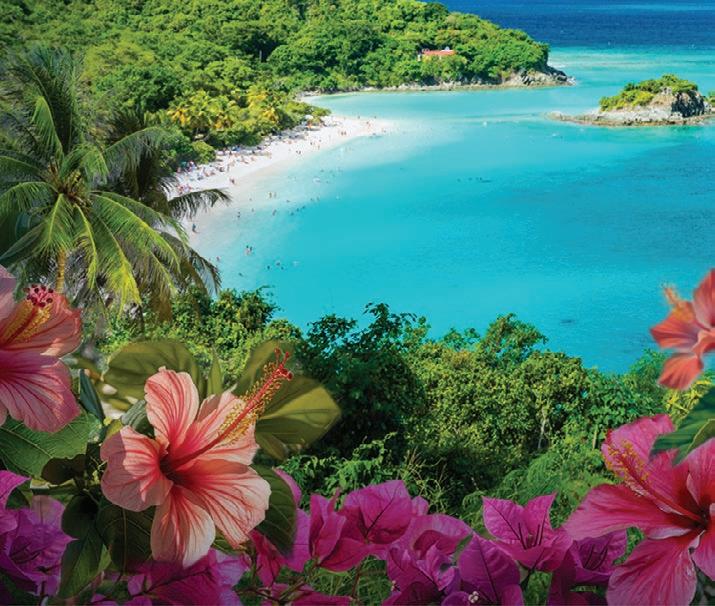
—Continued from the previous page
(As an aside, by the time we had reached Bermuda on that delivery we had learned to trim the gaff vangs that we had rigged, so that the twist was completely removed from the main and fore when sheets were eased. This removed the weather helm to the point that my daughter Dory, age 11, could stand a one-hour helm watch.)
In contrast was our experience aboard Pixie, a 54-foot Gardner-designed, ketch-rigged motorsailer that we were delivering from St. Croix to Ft. Lauderdale. The second day out, the hydraulic steering failed. However, it was no problem as Gardner had designed a proper emergency tiller. Pixie had a midship cockpit, so there was a large poop deck. We undid a deck plate, lifted a cushion on the aft cabin bunk, dropped the emergency tiller through the deck plate onto the rudder head, and we were all set. The tiller was a full six feet long, giving us plenty of leverage.
Almost all emergency tillers are designed to pass over the wheel steering stand. This arrangement looks good on paper but when you try to use it in heavy weather, especially going downwind, because of the height of the tiller, it does not work.
Today, most boats are so wide that a better arrangement would be to make the emergency tiller in a T going across the boat. This would be much easier to make and give a longer lever arm, plus, being in a T, two people could steer, one on port side, the other on the starboard side. The arms of the T should be made removable to facilitate easy storage of the tiller.
If the boat has a long stern, a centerline tiller can be installed with the tiller going aft from the rudder head.
In any case, have an emergency tiller that you know works. Before a passage, go out in heavy weather and test your emergency tiller, not only going to windward, but also on a broad reach and dead downwind, two points of sailing that require a lot of steering.
On cable steering systems the most common failure is broken cables. Replacing steering cables at sea is difficult, but not impossible. Megayacht skipper Billy Porter started his career in the Royal Navy as a teenager and retired as chief warrant officer after running the Royal Navy sail-training establishment. He tells the story of Great Britain II in a round-the-world race with only one stop.
The crew were all from the Royal Navy sailing program. They figured that on a race of this length, with thousands of miles sailing downwind in the Roaring Forties, they would have a steering cable break. When this happened, the boat would round up, the spinnaker would be doused, staysail hoisted, staysail main and mizzen trimmed so the boat would lie hove to until the broken cable could be replaced. One crewmember was told to get all the gear and spare cables assembled so that when the time came, he could replace the broken cable.
Inevitably, a steering cable broke and all went according to plan. The designated crewmember dove below to replace it, and the rest of the crew felt it would take him two or three hours to do the job. But 20 minutes later he popped out of the hatch and said, “New cable installed and tensioned; get underway!”
How did he do the job so fast? When Great Britain II was in port the crew lived ashore, but one crewmember always stayed on board as watchman. The crewmember who was in charge of the steering cables reported that every time he had the watchman duty, he would set his alarm for 2400; the minute the alarm went off he would dive into the lazarette and change a cable. The first time it took him almost three hours but each time he changed a cable he reduced the time necessary. He assembled all the tools he needed, stored them in the lazarette, and secured the spare cables there so that they were easy to run once he pulled the broken cable.
For those who are doing long passages with cable steering, it is worthwhile to try replacing a steering cable in port before going to sea.
Rudder Loss
Now that the vast majority of boats built in the last ten years have spade rudders, losing a rudder entirely by hitting something, or by having the rudder drop out, has become a common enough occurrence that in South Africa there is a company that makes emergency rudders specifically designed for your boat, which can be disassembled for storage until needed.
—Continued on the next page
—Continued from the previous page
But if you do not have an emergency rudder, do not waste time trying to rig a spinnaker pole with a door secured to it. I have heard and read about dozens of sailors who have tried this rig and it does not work.
Olivier van Noort, aboard a 55-foot cutter designed and built by De Vries Lentsch, lost her rudder in the 1953 Fastnet Race shortly after rounding Fastnet Rock. She rigged her spinnaker pole across the deck, ran lines through blocks secured to the ends of the pole, port and starboard. They were attached to a drogue streamed astern and led to winches. They were able to sail all the way back to Plymouth.
The late famous yacht designer Doug Petersen reported that halfway between California and Hawaii a very beamy one-tonner he designed lost her rudder. They sailed all the way to Hawaii using the same rig as Olivier van Noort but the one-tonner was so beamy they just led lines port and starboard through blocks secured to the rail cap at the widest part of the boat.
Offshore sailor Mike Keyworth once demonstrated how he could sail a Swan 44 that had the rudder and skeg removed and replaced by a spade rudder. He removed the spade rudder and then demonstrated that he could steer the now-rudderless boat by towing a Hathaway, Reiser & Raymond “sea brake” drogue.
He beat to windward, tacked, reached, ran and jibed, all with no rudder, steering strictly by trimming the sails and adjusting the drogue.
My favorite story of all is the story of Williwaw, a 48-foot sloop that lost her rudder in 1978 while racing the Middle Sea Race for the Sardinia Cup. The crew felt they should drop out and secure a tow but the skipper, Lowell North, and the mate, Peter Barrett, both Olympic gold medalists, insisted that they could continue the race and finish, steering by carefully trimming the sails.
This they did. To put icing on the cake, Lowell and Peter insisted on sailing into the marina, including tacking, all with no rudder on a short-keeled racing machine.
With the wind abeam or forward of abeam good sailors on most boats can steer a boat using sails only. This is easy on a ketch or yawl, hard but possible
on a sloop or cutter. The cutter with a staysail as well as a jib is easier to steer under sail alone than a single-headsail sloop. Once the wind goes aft of abeam, switch to the drogue routine.
In the light of all the above, loss of steering or loss of rudder should not be regarded as a complete disaster but rather a major inconvenience.
Sailing Yacht, Volume 2 on the market, but there is still a ton of valuable timeless information there.
read The he is a seaman.”

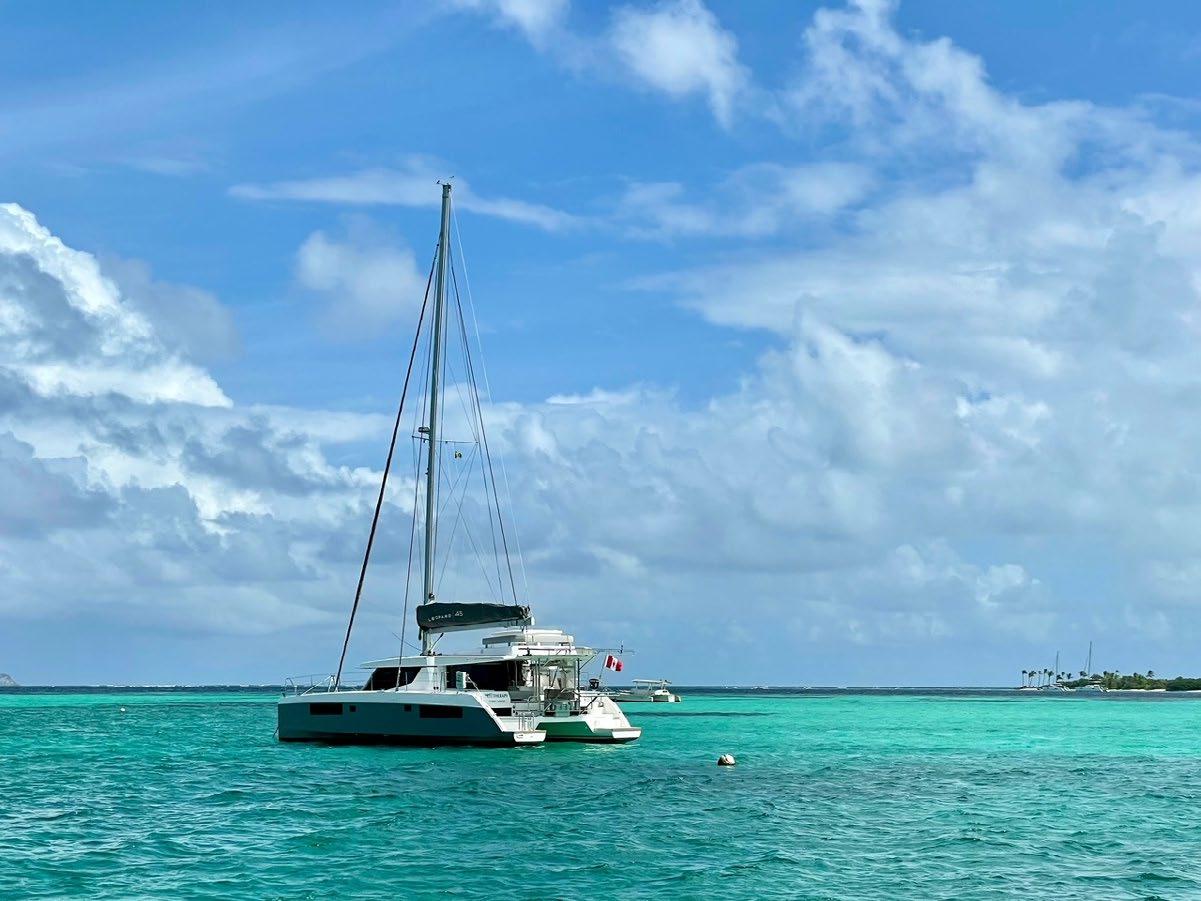
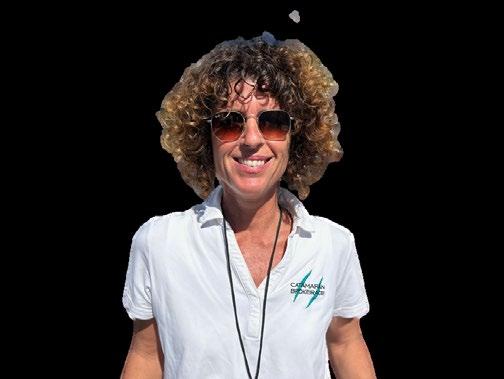
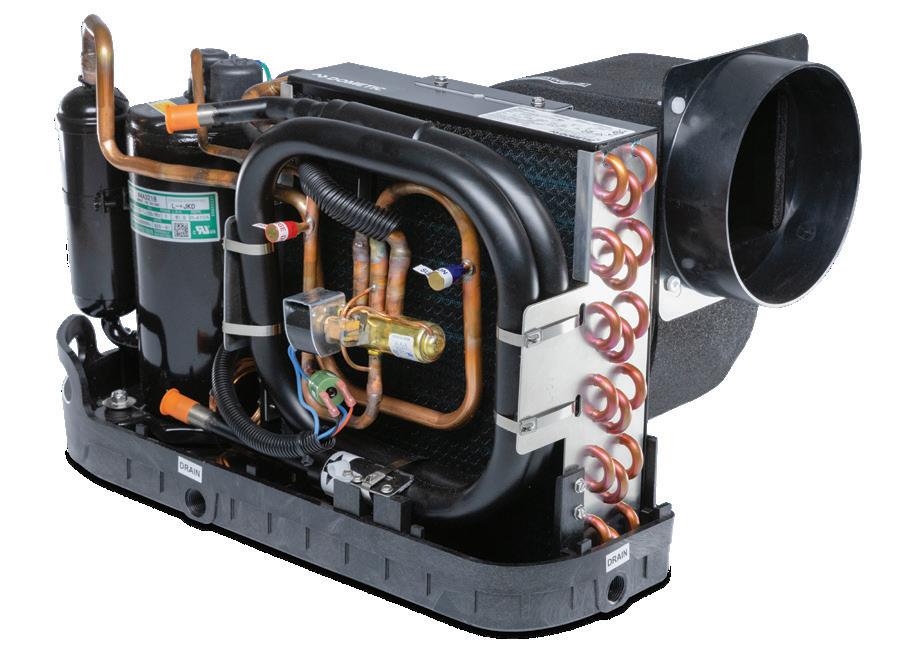




Some places are destinations; others are experiences that never truly end. Scrub Island Resort, Spa & Marina belongs to the latter. Open 365 days a year, this private island sanctuary in the British Virgin Islands thrives on the rhythm of the sea, the warmth of its people, and the freedom of unhurried days. Here, every season holds its own invitation — whether that’s sailing across turquoise channels, savoring Caribbean flavors, or retreating to a hillside villa where time slows.
From its early beginnings as a quiet anchorage known only to sailors, Scrub Island has grown into a AAA Four-Diamond resort community that welcomes guests from around the world. It offers a lifestyle that balances the comforts of luxury with the authenticity of island living. Yet despite its evolution, Scrub Island has never lost the qualities that made it magnetic in the first place: natural beauty, a spirit of adventure, and a rare sense of belonging.
The Marina: Gateway to the BVI
For sailors, Scrub Island is more than a resort — it is a trusted waypoint. The award-winning marina features 55 slips, including five dedicated to mega yachts up to 170 feet. Known as one of the cleanest marinas in the British Virgin Islands, its turquoise waters are so clear that even a walk along the dock feels like an immersion into an underwater paradise.
Centrally located at the heart of the resort, the Scrub Island Marina is surrounded by the restaurants and amenities of Marina Village. Cardamom & Co. and Donovan’s Reef Marina Bar & Grill sit just steps away, along with the Harbor Boutique, fitness center, Dive BVI, convenient marina showers, and a fueling station. The Scrub Island Outpost serves as the island’s provisioning hub and more, supplying everything from daily needs to gourmet items, ensuring both boaters and resort guests have exactly what they need. From almost anywhere in the resort, the marina serves as a scenic focal point, its constant activity bringing energy and charm to daily life on the island.
Perfectly positioned within the BVI’s line-of-sight sailing routes, the marina functions as both a jumping-off point for island-hopping and a welcoming harbor to pause, provision, and enjoy all the comforts of the resort. Anglers will also find Scrub Island an enviable base, thanks to its proximity to the legendary North Drop — one of the world’s premier blue marlin fishing grounds.
Scrub Island’s dining experiences are as varied as the moods they inspire. At Cardamom & Co., fine dining comes to life through spice-trade flavors and thoughtful presentations, all framed by sweeping views of the marina and neighboring isles. Donovan’s Reef Marina Bar & Grill captures the easy energy of poolside dining, where crisp salads, fresh sandwiches, and tempting appetizers are best enjoyed with the breeze or from the comfort of the swimup bar.
For a toes-in-the-sand atmosphere, One Shoe Beach Bar & Grill at North Beach serves laid-back favorites that keep guests lingering long after their meal. And just across the channel, Marina Cay Bar & Grill adds its own charm
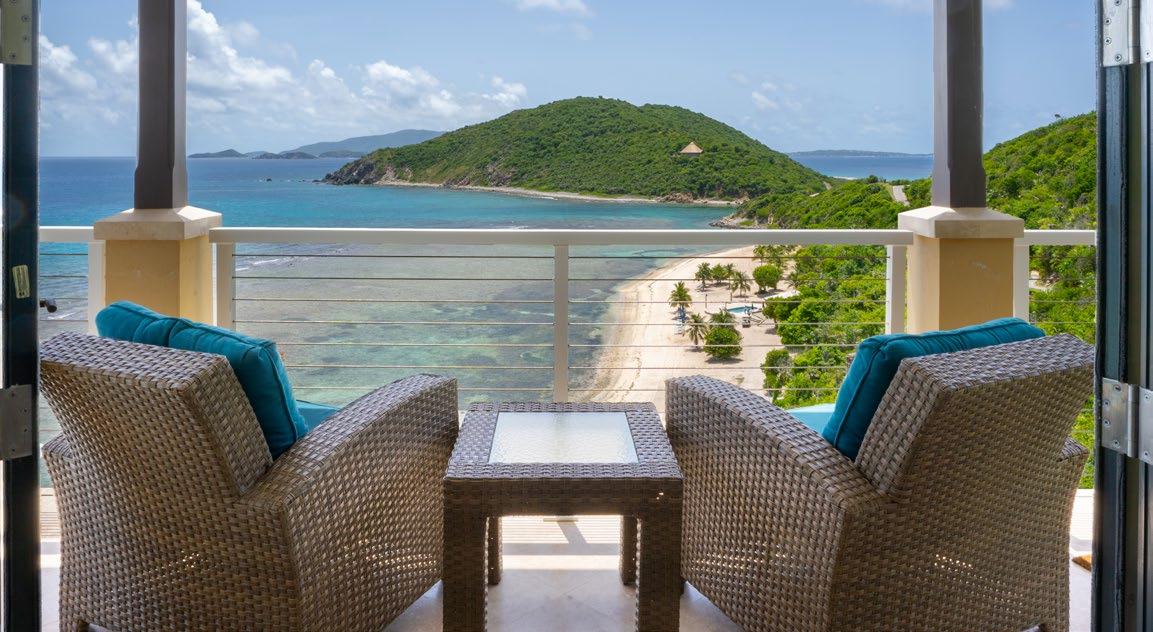
with a breezy, open-air setting, approachable island fare, and panoramic views that make every bite unforgettable.
Perched high above the resort, Ixora Spa is where nature and serenity converge. Featuring the luxurious products of ELEMIS, the spa delivers masterful Ayurvedic treatments that go far beyond relaxation. Guests may choose from anti-aging facials, reviving body scrubs and wraps, or timeless massages designed to release even the slightest traces of tension.
The experience extends well beyond the treatment rooms. A tranquil terrace invites guests to begin their day with sunrise yoga, while the spa’s plunge pool offers a refreshing pause between therapies, framed by sweeping views of the Caribbean Sea. Treatments are designed for men, couples, and groups, as well as creative packages that blend multiple therapies into one indulgent session. The spa is designed to frame sweeping ocean views, reminding guests that the healing power of the island is part of the experience.
Here, highly trained therapists pair advanced formulations with intuitive techniques, ensuring that every treatment delivers results as well as calm. At Ixora Spa, time slows, the senses heighten, and the island itself becomes a partner in wellness.
Adventures on the Water
Adventure is never far, and at Scrub Island it begins just across the channel on Marina Cay. In partnership with Up ’n’ Under Watersports, the eight-acre islet has become a hub of aquatic excitement, offering experiences that range from exhilarating to serene. Guests can soar above the waves on eFoils, harnessing freedom of flight with nothing but a wireless controller and the open sea. For those who prefer a burst of speed, AquaDarts deliver Caribbean power snorkeling at up to 22 kilometers per hour, making it effortless to skim the surface or dive deeper into Diamond Reef’s vibrant world below.
—Continued on the next page
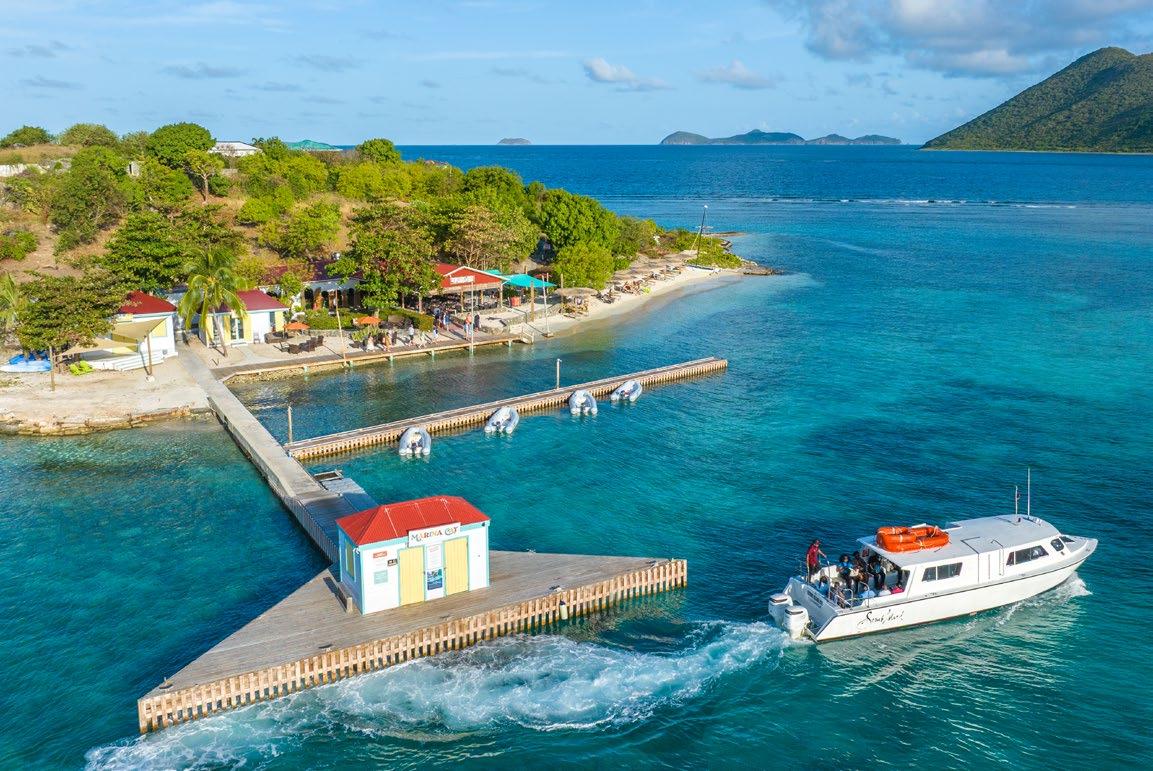
Not all adventures need to be fast. Kayaks and stand-up paddleboards provide the perfect pace for exploring turquoise waters and quiet coves, while snorkel rentals reveal the island’s reef-ringed underwater paradise, alive with colorful coral and marine life. Whether paddling, gliding, or diving, Marina Cay invites guests to choose their own rhythm of discovery.
What makes the experience complete is the seamless flow between action and ease. After a morning on the water, guests can step straight into Marina Cay Bar & Grill, trading fins or paddles for a breezy open-air lunch with panoramic views. From adrenaline to appetite, the island delivers both sides of the adventure, before Scrub Island’s ferry carries guests back to the comfort of their private retreat.
Spaces to Call Your Own Accommodations at Scrub Island are designed with flexibility and personalization in mind.

Ocean-view guestrooms and suites provide a classic resort experience, combining plush bedding, spa-inspired bathrooms, and private balconies with views of Marina Village and the Caribbean. These intimate sanctuaries are perfect for couples or solo travelers seeking comfort in a compact, elegant space.
For families and groups, luxury hillside villas offer expansive, residentialstyle living. With two to six bedrooms, fully equipped kitchens, private pools, and wide terraces overlooking the sea, each villa becomes a world unto itself. Thoughtful design ensures privacy while maximizing breezes and views, turning each stay into a retreat defined by space and serenity.
Beyond short-term stays, Scrub Island also offers ownership opportunities. Fully furnished condominiums, well-appointed villas, and pristine homesites allow investors to make the island a permanent part of their story. A dedicated on-site real estate team supports every stage of ownership, while an established rental and property management program keeps properties
impeccably cared for year-round. Owners enjoy not only a personal retreat, but also the assurance of strong rental demand within one of the Caribbean’s most desirable destinations.
Nature’s Twin Canvas
Scrub Island is unique in its formation. It is not one island but two—Big Scrub and Little Scrub — connected by a slim isthmus that creates a natural division between preserved landscapes and thoughtful development.
Big Scrub, at 170 acres, remains largely undeveloped. Its high ridge offers breathtaking 360-degree views, while trails lead to overlooks that showcase the Caribbean’s natural beauty in its purest form. It is here that guests can experience the Caribbean as it once was, unspoiled and untamed.

Little Scrub, at 60 acres, forms the heart of the resort. Restaurants, villas, pools, and marina village are carefully integrated into the landscape, ensuring that development enhances rather than diminishes the natural setting.
Together, these two halves illustrate the balance that defines Scrub Island: preservation and innovation, solitude and connection, nature and comfort.
Though private and self-contained, Scrub Island is surprisingly easy to reach. With new direct American Airlines flights from Miami to Tortola’s Terrance B. Lettsome International Airport (EIS), access to the BVI has never been more convenient. After clearing customs, guests are whisked by car to the resort’s private ferry at Trellis Bay, less than a mile away.
From there, the transformation begins. A short 15-minute ferry ride becomes an initiation into island life — the sun warm on your shoulders, sea breezes in your hair, and the silhouette of Scrub Island rising on the horizon. By the time you arrive, the stress of travel has already melted into anticipation, replaced by the smiles of the resort’s welcoming team.
Scrub Island is not bound by traditional high and low seasons. Its appeal is constant, shaped by year-round sunshine, steady trade winds, and calm Caribbean seas. Whether in the vibrant height of summer, the quiet months of autumn, or the festive glow of winter, the island maintains its rhythm.
Cultural events across the BVI — from sailing regattas to local celebrations — add color and energy throughout the calendar. Yet even without them, Scrub Island remains a world of discovery: hiking trails, reef snorkeling, spa indulgences, villa dinners, and long afternoons spent doing absolutely nothing.
This consistency makes Scrub Island a rare promise in a changing world: an escape that is always ready, always waiting, always open.
At its core, Scrub Island is not simply a resort or a marina. It is a way of life, lived at a different pace. It is in the laughter of children racing down a waterslide, the quiet focus of a sailor charting a course, the clink of glasses raised at sunset, and the deep calm of a massage that seems to last longer than the hour booked.
Here, presence becomes the ultimate luxury. Guests and residents alike discover that Scrub Island does not end when a vacation does — it lingers, calling you back again and again. Some places are destinations; Scrub Island Resort, Spa & Marina is an experience that never truly ends.
Your story begins at scrubisland.com.
By Chris Doyle
Losing a rudder and abandoning ship on occasion has surfaced on several sailors’ Facebook pages. The most recent incident involved a small yacht that landed in Union Island minus crew, who had abandoned her in the Atlantic after the rudder fell off. That took me back to the only delivery I did where our steering failed catastrophically. Then, of all strange coincidences and out of the blue, the following e-mail arrived:
“I know this sounds crazy but I am wondering if you are the Chris Doyle who helped my parents (Willard and Liz Hain) sail the yacht Traumerei in the ’70s from Florida to Grenada. Well, actually we ended up in St. Thomas because we lost the rudder, but you get the gist. I was about seven or eight years old and I went by Susan then.”
Although Susan was just a kid at the time, she remembers the rudder rightly. We did finally end up in Grenada, after a breakdown stop in St. Thomas. This happened long ago and I’ve been lucky to now be back in touch with two of the other participants to help fill in details.
The Delivery
As a delivery, Traumerei was great. She was a sturdy boat around 38 feet long, maybe 15 years old, that came with her owners, who knew her very well, their delightful daughter, Susan, and a handy teenager called Kevin who was the son of a friend. So why pay me to come along? Well, Willard, although very capable, was having some problems with his eyesight, as I remember, and could not see too well. Luckily, his ears were still perfect and he loved music and kept a huge supply of classical tapes on board. Liz, quite a few years younger (it was a second marriage), was a very practical and able woman, but she was also homeschooling Susan, and was perhaps not confident enough to feel she could take charge if need be. If Traumerei had a downside, it was that she had a gas engine, though Willard was well attuned to it. Traumerei also had a small fuel tank, so Willard had many jerry jugs of gas securely lashed to the rail with wooden boards sandwiching them on both sides.
I did wonder about those gas jugs as we left Florida and all around us were lightning storms. Still, it was Day One and to suggest we ditch our entire fuel supply on the off chance we might be struck (and even then I had no idea what would happen if we were) seemed more than excessive. Happily, we never got directly in a storm. We were later to be very grateful for the wooden boards.
We followed the usual course for deliveries to the islands: we sailed to the Bahamas, cut through them to the Atlantic Ocean and beat our way southeast (no “Thornless Path” when you are trying to make time).
This was before the invention of GPS and one of the pleasures of being a skipper was your shaman-like ability to wave an instrument at the sun, do some additions and subtractions, and proclaim, “This is where we are.” The best time to be the shaman was when you were about 35 miles off an island after a week or more at sea and could say, “We should spot land straight ahead any time now.” Very soon, someone would say “Land ho!”
And that is where we were, with St. Thomas in sight, when there was a “crack” and we lost one of the lower shrouds. We put the boat about immediately to take the strain off the broken stay. Luckily, it had broken not far from the turnbuckle so it was not too hard to make a temporary repair. Willard had packed his boat with gear, and was ready for almost anything (just as well, as it turned out). He managed to find a bulldog clamp of the right size, so we bent the wire in a big loop, clamped it, lashed it well to the turnbuckle, tightened it up, and continued to St. Thomas.
Our next minor problem was that as we approached, the engine would not start, as the batteries were flat. When we had last used the motor, the ignition had somehow been left in the “on” position. Happily, in those days there was a big long dock with plenty of room in Charlotte Amalie. Taking the helm while coming alongside a dock under sail on someone else’s boat, which is also their home, makes me nervous, but the approach was into the wind and we could control the speed by letting the sails flap. Willard had a good stock of fenders, which we deployed to the full, so if our arrival was not exactly elegant, at least we did no damage.
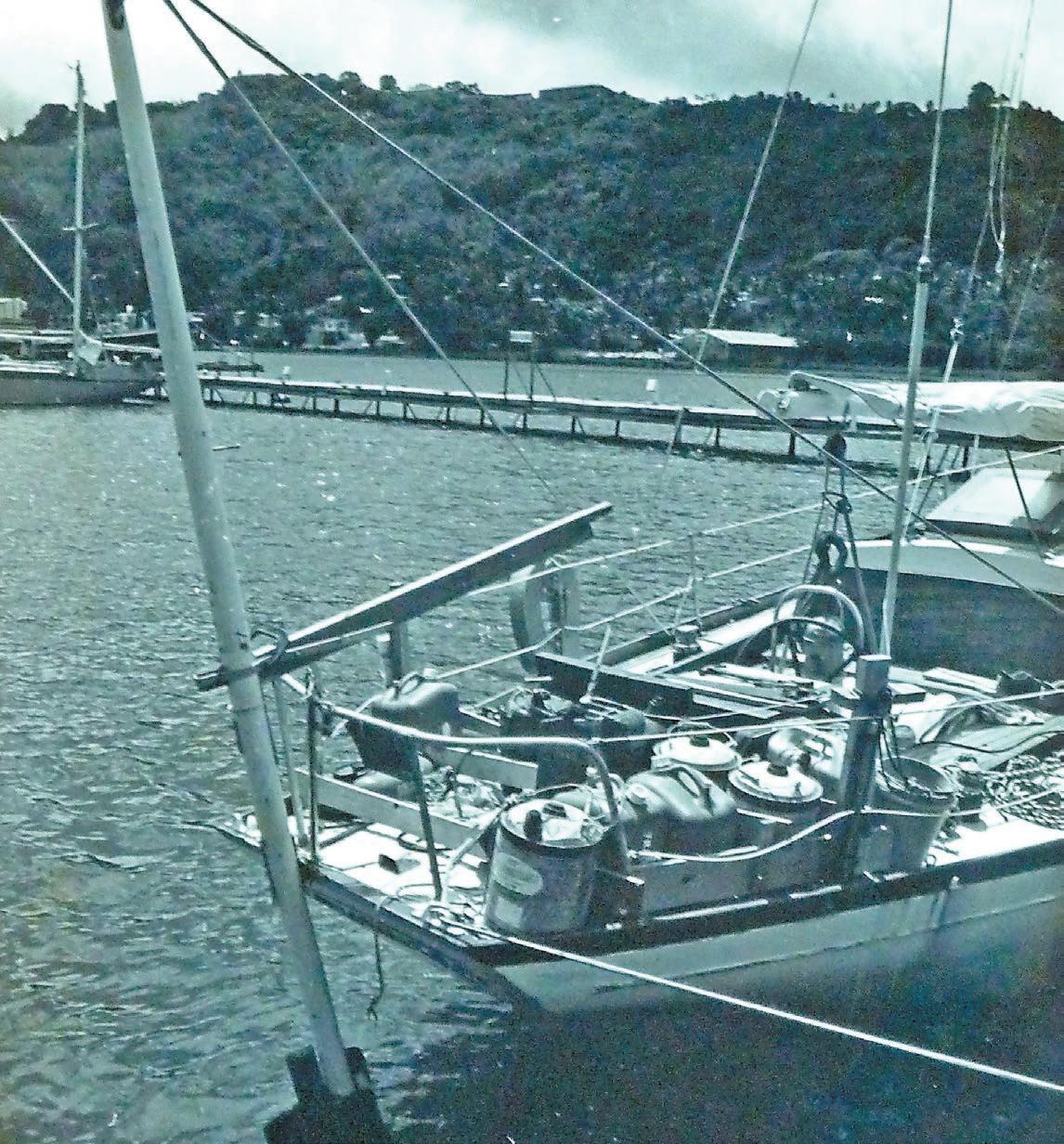
We had now sailed well over a thousand miles but still had around 400 more to reach Grenada, and we did not want to chance it with rigging that had proved dodgy, so we decided to take a few days and re-rig. Back then, St. Thomas had very little for yachts. There was a marina, one marine mechanic, and a chandlery of sorts. The rigging was 5/16ths inches in diameter, and we were unable to find the same to replace it. We could, however, buy quarterinch stainless rigging wire and the Norseman fittings to go with it, so we decided that brand new quarter-inch would be much stronger than what we had, and we changed it all, using the very easy, do-it-yourself Norseman fittings. Willard was relieved and well pleased with the job.
Steering is Gone!
We set sail again on an optimistic note. We had new rigging wire, and we were now in the Caribbean Sea, not the Atlantic, where the tradewinds were blowing reliably. As always on a delivery, we planned the shortest route and set a direct course to Grenada, heading up a fair bit to allow for current. With Liz in charge, the food was good and there were plenty of healthy snacks; one of my favorites was to spread peanut butter in a stick of celery and munch away. No corned beef and crackers on this trip! The first night at sea was great: The trades were consistent and moderate. What could go wrong?
The next day, Kevin was on watch when there was a flapping of sails, and a call that “the steering had gone.” As skipper I came into the cockpit and I had to try for myself just to make sure. He was right. I asked him to go look at the steering quadrant and see what was happening; with a bit of luck a wire would have broken and we could fix it. “The rudderstock has broken, the quadrant is flapping around and water is pouring in.” Not so good. Having no steering is not an immediate threat to life; a leak can be. Inspection showed that the stock, which had been built of hollow stainless tube, had sheared somewhere down in the rudder shaft and water was pouring out of the top. It was not too hard to cap it and stop the water. What next?
—Continued on the next page
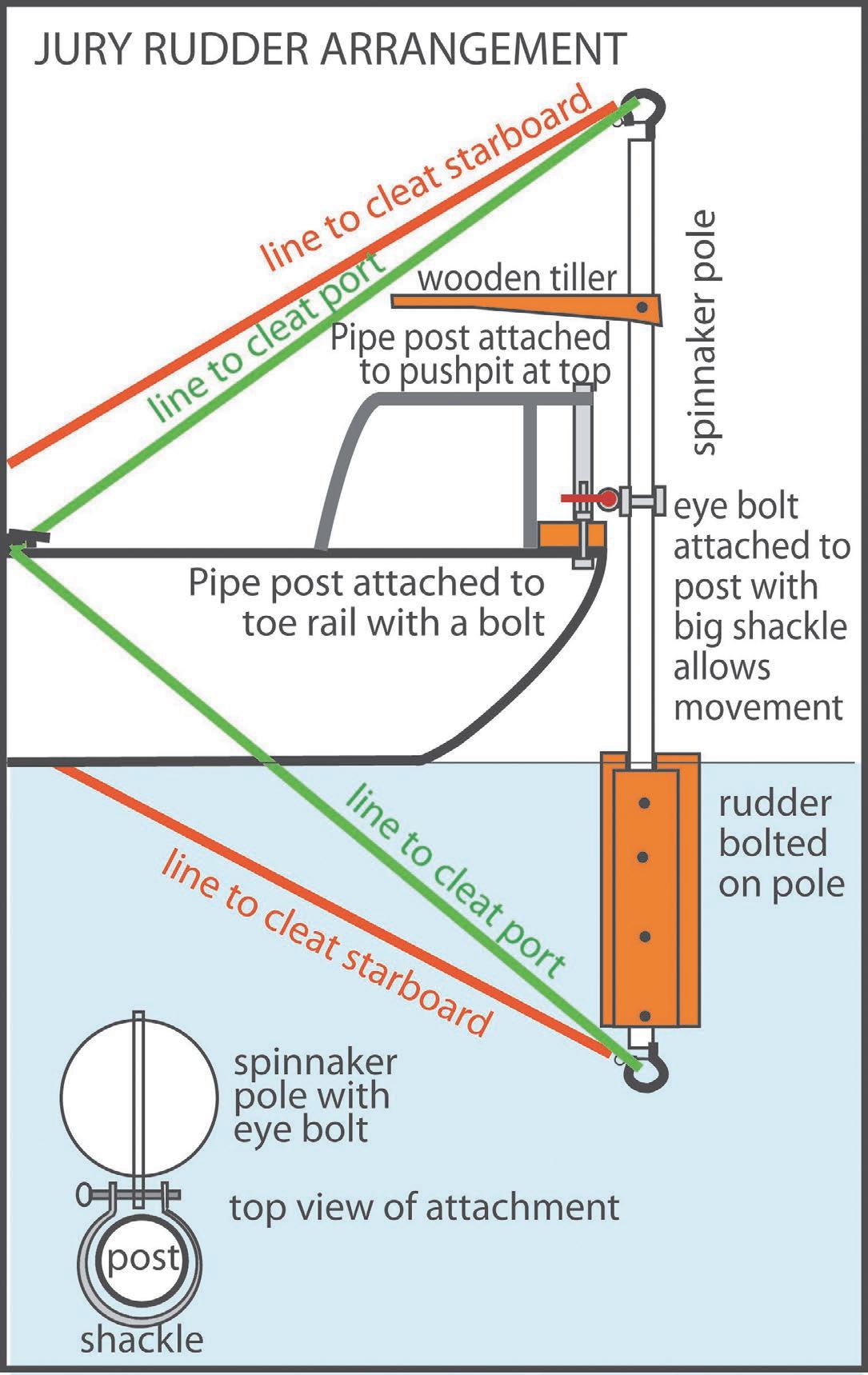
Would the bottom part of the rudder just sweep away to sea?
To overcome this, we decided to stay it. Two ropes from the top and two from the bottom of the pole leading to cleats on either side, level with the cockpit, should keep it aligned enough to use.
We lowered sails to assess the situation. Kevin said he would be happy to snorkel over the side and see how the rudder looked. I thought that if the rudder was still securely in place and mobile, we might find a way of attaching a port and starboard line to the aft part of the rudder, bring them up to each side of the boat and thus steer. I seemed to have a memory that some of the old English barges had a hole drilled at the aft end of the rudder for just that purpose. Willard surely had just the right clamp to make the attachment. On surfacing, Kevin was not enthusiastic. The rudder was hanging in there but maybe not too securely, and there was so much movement from the seas, an attachment would, in any case, be problematic.
We were at this time 24 hours out of St. Thomas on a direct course for Grenada, and the nearest land was Saba, about 60 miles due east, well out of sight. Could we get any help? Or at least alert someone that we had a problem? That proved difficult. Willard had equipped Traumerei with the very latest in marine radios: a VHF. But it was a fairly new system at this time and had not reached the islands. In those days, both yachts and ships in the Caribbean still used old battery-draining AM transmitters. Still, we gave it a go. No one was listening.
This should surely have been the time to beat my breast, gnash my teeth, fall on my knees and pray to some improbable deity, or at the very least have a minor panic tantrum, but it was hard to do. We were in the Caribbean Sea, the sky was blue, we were well fed and the crew were all very calm. They gave the impression that they were sure this was the kind of stuff a delivery skipper dealt with every day, so it could not possibly be a problem, could it?
—Continued on the next page
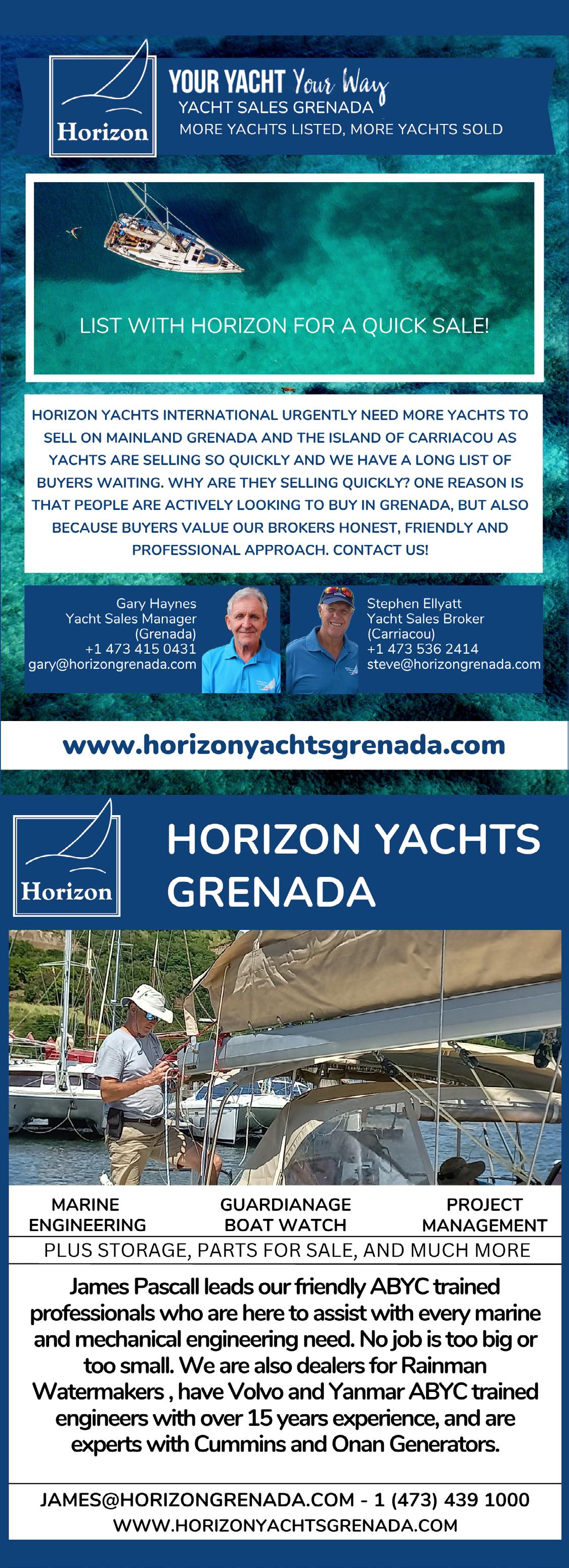
—Continued from the previous page
Jury-Rig Steering Options
It so happens that at some point on my journey to Florida I had picked up some American yachting magazine and read an article on “what to do when your rudder breaks.” What a relief — or maybe not.
We decided to re-hoist the sails and see if we could steer some kind of course by balancing them. Then as we moved along we could refine our steering according to the article. The boat was well balanced and we found she would sail along nicely if we sheeted the jib in, and then we could steer higher or lower by easing or tightening the main. By letting the main out a long way and playing with the jib we could even get her to go on a beam reach.
This was a pretty good range. Even better, if we got her clipping along on a close reach we could heft the main in tight. Then she would come up into the wind, the jib would back, and we could tack her. It was a slow and cumbersome tack, but it could be done. We managed to get her on a comfortable close reach toward Grenada. To do this the jib was in fairly tight and the main well out with the top third of the leech, flapping.
Now that we were moving, we decided to try to fine tune the steering à la the yachting magazine article. The first thing we tried was a steering oar, which seemed to make sense. We constructed a reasonably decent oar using the hollow wooden spinnaker pole with a short plank bolted to it. We even shaped the plank a bit. With high hopes we lashed it securely to the center of the aft part of the boat, and then tried steering. In one sense it did steer the boat well; if you could move it, the boat turned. In another it was hopeless; in the Caribbean seas the forces on the thing were horrendous. It took three people tugging with all their might to even begin to control it. That would not do.
Next we tried the bit where you drag something astern and steer by moving it from side to side. That also might work on a calm day in a flat sea, but was hopeless in the ocean. Still, balancing the sails was working beautifully: we were right on course for Grenada. The downside came at night when we saw shipping and thought it was coming toward us. We had to tack while still a mile away to make sure we did not get close. Also, the continuously flapping sail took a toll on the stitching. At breakfast each day we would take the main down and Liz would hand stitch all the seams that were coming apart.
We had fair confidence that we could sail right up into the lee of Grenada just as we were going. But what then, when we hit the fluky lee-shore winds? We needed a rudder and put our minds to how to construct it.
Traumerei had a long overhang at the stern and secure pushpit. Had the pushpit had a support right at the back of the boat it would have been ideal as a single pivot point for a rudder, right aft. Since there was not one there, we decided to construct one, fastening a post from the toerail to the pushpit. (As I look at the photo, it appears that we cannibalized some tubular bit of gear for this. I remember using a bolt upward though the toerail to secure the bottom, and somehow we secured the top to the pushpit.) The spinnaker pole was to be our rudder shaft, and if we put an eyebolt through it, we could attach it to our post with a big shackle that would go right around the post, allowing for rotation and plenty of movement. Had we not been so well equipped, we would have had to resort to some creative lashing.
But, you may ask, what use is a single pintail? The bottom part of the rudder would just sweep away to sea and mash up the whole arrangement. To overcome this, we decided to stay it. Two ropes from the top and two from the bottom of the pole leading to cleats on either side, level with the cockpit, would hardly create a rigid structure, but it should keep it aligned enough to use. We decided to give it a try.
Willard had good tools and lots of hardware, and he was good at carpentry, so he, Kevin and I worked on the new rudder. We had plenty of time — after all, no one had to steer now. The wooden planks that sandwiched the fuel cans stored on deck were used to make the rudder blade. One thing that the steering oar fiasco had taught us was that the blade did not have to be very big. My memory may be faulty, but I think we made it about a foot wide and two to three feet high, starting with a board either side of the spinnaker pole and securely bolted through it. We wanted the steering to be easy, so we balanced it with about 15 percent of the area in front of the shaft, the rest behind. A few feet above the pivot point we fastened on a plank shaped to be a tiller, using some old metal strapping. Since the boat was sailing so well, there was no hurry to deploy it; we would wait till it was needed.
The Proof
Three days after we lost the rudder we arrived within a few miles of Grenada

and, as we came into the lee, the wind died. Time to try our rig. Since we were not moving, it was easy enough to install. In the swell our jury rudder rolled from side to side at the back of the boat in a pretty wide arc, but with the ropes tensioned fairly tight it was stable enough. We started the engine and put it in gear. To our delight the jury-rigged rudder worked perfectly, just like a real one. A few hours later we came into GYS (now Port Louis) in St. George’s and tied to a dock. The weird contraption on the stern attracted attention and people came by to hear our story. We all felt a sense of achievement for having dealt with this crisis and arriving safe in port unaided.
Willard went off to organize the first steps for a real repair and got an appointment to haul the boat in Prickly Bay the next day. The rudder worked well enough that we figured we could sail the six miles there, though we did make arrangements for people to come look for us if we failed to show. The rudder worked so well that we were able to sail there without a problem.
As the boat was hauled we could see that cracks were beginning to appear on all the spinnaker poles’ glued seams. It had worked perfectly, but would not have lasted much longer. The real rudder was still hanging in place, so it just needed a new shaft.
Epilogue
Susan told me a little of what had become of the Traumerei crew.
“I now live outside of Vail, Colorado (in the mountains) and suffer through each and every winter by looking forward to our yearly holiday trip to the Caribbean and summer in the Rocky Mountains. I’ve lived here longer than I’ve lived anywhere in my life (23 years) and my 19-year-old son and 15-year-old girl-and-boy twins have grown up here, becoming avid skiers and soccer players. I moved back to the States when I was 13 to live with my dad (Willard was my stepdad) and go to school. I continued to visit my mom and Willard every summer (by then they had moved from Grenada to Puerto Rico) until I went to college and had my own life.
“They eventually brought Traumerei back to the States, sold her, and became land bound for a while. About ten years into that they got a wild hair up their butts and bought Liebestraum, a 40ish-foot Gulfstar, and came back to Puerto Rico for a stint. Once Willard got too old to live on the boat they retired in South Carolina where my mom still lives. Willard died about five years ago but my mom is still kicking at 83. My mom treats us to a trip once a year (usually right after Christmas) and we charter a boat and go somewhere in the Caribbean.”
1-6 Tobago International Cycling Classic. visittobago.gov.tt/festivalsevents
3 Zoom Lecture: Environmental Impacts of Invasive Species, Elizabeth Esser, Mississippi State University. 9:30 AM, Zoom Meeting ID: 834 1808 4388
4 Caribbean Gospel Festival, Guadeloupe
6 FULL MOON (Harvest Moon)
10-12 Belikin Blue Water Classic Fishing Tournament, Belize
12 Clean Coast Bonaire. www.infobonaire.com
13-20 KoSA Cuba Havana & Fiesta del Tambor. kosamusic.com/kosa-cuba/ 14 Public holiday in St. Lucia (Thanksgiving Day); in Puerto Rico and USVI (Indigenous Peoples Day); in the Bahamas (National Heroes Day)
16-20 Drummer's Cuba Tour: Fiesta del Tambor
17 La Marguerite Flower Festival, St. Lucia
18 Willy T Virgin’s Cup Race, BVI. www.royalbviyc.org
20 Public holiday in Trinidad & Tobago (Divali)
20 Tobago Blue Food Festival. visittobago.gov.tt/festivals-events
21-30 The Moorings Interline Regatta, BVI. moorings.com/regattas-andevents/interline-regatta
24 Creole Day (Jounen Kwéyòl), culmination of Creole Heritage Month, Dominica
24 Zoom Lecture: Indigenous Science and Forest Resilience, Thi Mai Anh Tran, Michigan Technological University. 9:30 AM, Zoom Meeting ID: 834 1808 4388
24-26 World Creole Music Festival, Dominica. www.dominicafestivals.com
24-26 Tobago Carnival. www.visittobago.gov.tt
25 Public holiday in Grenada (Thanksgiving Day)
26 Creole Day (Jounen Kwéyòl), culmination of Creole Heritage Month, St. Lucia
27 Public holiday in St. Vincent & the Grenadines (Independence Day)
TBA Bonaire Regatta. www.infobonaire.com
TBA Jong Bonaire “Swim to Klein.” www.infobonaire.com
TBA Carriacou Corn Festival. www.puregrenada.com/events/carriacoucorn-festival/
TBA Foxy's 28th Annual Cat Fight, BVI
TBA Haiti Cup fishing boat regatta, Cap Haitien, Haiti. www.haitisailingcup. com
TBA International Choir Festival, Santiago de Cuba
TBA Parang Festival, Trinidad
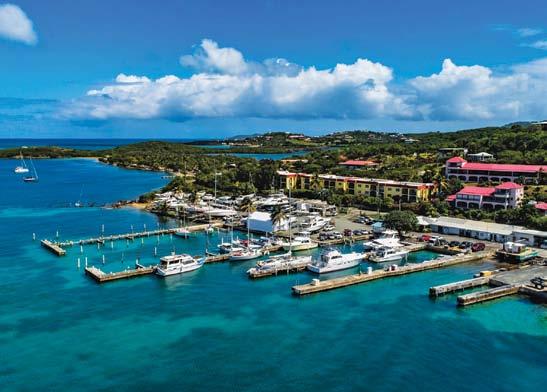
• Mercury Dealership
• Full Chandlery
• Marine Store and Yard Services
• Mercury Dealership
• Dockage – 44 fixed slips
• 5 Available Moorings
• Full Chandlery
• Maximum vessel size: 125 Feet
• 40 Ton, 17.5’ Max Beam Travelift
• Haul and Launch
• Fuel Dock – Gasoline and Diesel
• WIFI
• Washrooms and Showers
• Dockage – 44 fixed slips
• Ice and Beverages
• 5 Available Moorings
• Maximum vessel size: 125 Feet
340-773-0289 | Hail VHF 16
• 40 Ton, 17.5’ Max Beam Travelift
• Marine Store and Yard Services
• Haul and Launch
• Fuel Dock – Gasoline and Diesel • WIFI • Washrooms and Showers • Ice and Beverages
See the entire calendar of events at caribbeancompass.com/caribbean-events-calendar 5063 Gallows Bay, Christiansted, VI 00820

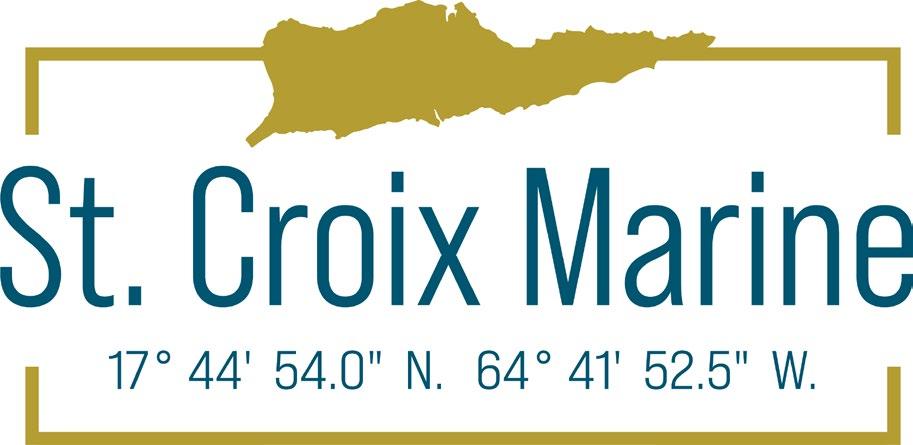

Reports of record-high murders and gun violence in Trinidad have understandably given some sailors pause. “Is it safe to sail to Trinidad?” is a frequent question in online forums. The answer, fortunately, is still “yes.” Most crime is gang-related and concentrated in Port of Spain, far from Chaguaramas, the island’s yachting hub and home to the Coast Guard. For most cruisers, recent experiences in Chaguaramas have been overwhelmingly positive.

Concerns about piracy in the waters between Trinidad and Venezuela are also common. However, while there were seven incidents between 2015 and 2019, there have been none since. Increased Coast Guard patrols, along with float plan monitoring and VHF coordination by North Post Radio and the Marine Services Association of Trinidad and Tobago, have likely contributed to this improvement. Hundreds of yachts safely make the passage to and from Trinidad every year, often to haul out for the hurricane season and take advantage of the plethora of affordable general and technical yacht services Chaguaramas has to offer.
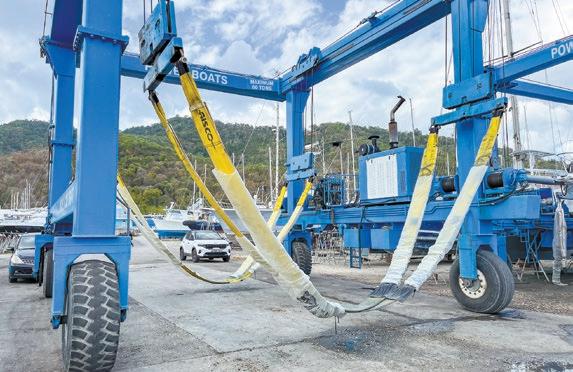
They say that when Columbus landed on Trinidad he stumbled into a big party. Today, Trinidadians remain fun-loving, hospitable people who do indeed love partying. Steel pan music was invented here, a by-product of the oil industry and its discarded oil drums. Calypso,
too, had its birth in Trinidad. These musical forms combine to help make Trinidad’s carnival one of the world’s finest celebrations.
Trinidad seems to reach out and almost touch Venezuela. The two were linked together only 11,000 years ago when the last ice age lowered the sea by 300 feet. It shares a rich diversity of plants, birds, and insects with the South American continent, and because it is an island, the abundant wildlife is more condensed and easily accessible than it is on the continent.
South American Indians inhabited Trinidad when Columbus arrived in 1498. The early Spanish colonization in 1776 was not successful, as the Spanish were too busy plundering South America. Governor Chacon then offered free land to all newcomers, and the colonization of Trinidad got underway with help from many French settlers. Port of Spain became the main town.

The British captured Trinidad and Tobago in 1797 and held the two islands until independence. In the early days Trinidad had a flourishing plantation economy based on sugar. The plantocracy found itself short of labor after the abolition of slavery, when former slaves quite naturally wanted no part of working on the plantations. The landowners’ solution to the problem was to import some 150,000 indentured servants from India. Today, Trinidad’s population is a blend of Indians, Africans, and Europeans, a mix that has generated some exceptionally good-looking people. Trinidad has a population of 1.2 million, about 350,000 of whom live in Port of Spain. Trinidad and Tobago became an independent twin-island state in 1962, a democracy in the British tradition. During the last world war, the United States established major naval and air bases in Trinidad. They served to protect oil shipments to England, which were prime targets for German U-boats.
Trinidad has the good fortune to have large deposits of oil and natural gas, and a pitch lake. As a result it is more industrialized than the rest of the Caribbean and produces, among other things, steel and ammonia, which are exported. Trinidadians also build ships and undertake major construction.
—Continued on the next page

Trinidad is modern. It has large shopping malls, similar to those in the USA, good roads and excellent repair and service facilities for yachts and superyachts. Many yachtspeople enjoy spending part or all of the hurricane season here. The sightseeing is good, the hospitality great, and Port of Spain is a thriving, bustling town where something is always happening. In the north, Chaguaramas is a great place to overhaul your yacht and enjoy yourself at the same time, and a very secure place to leave your boat in dry storage.
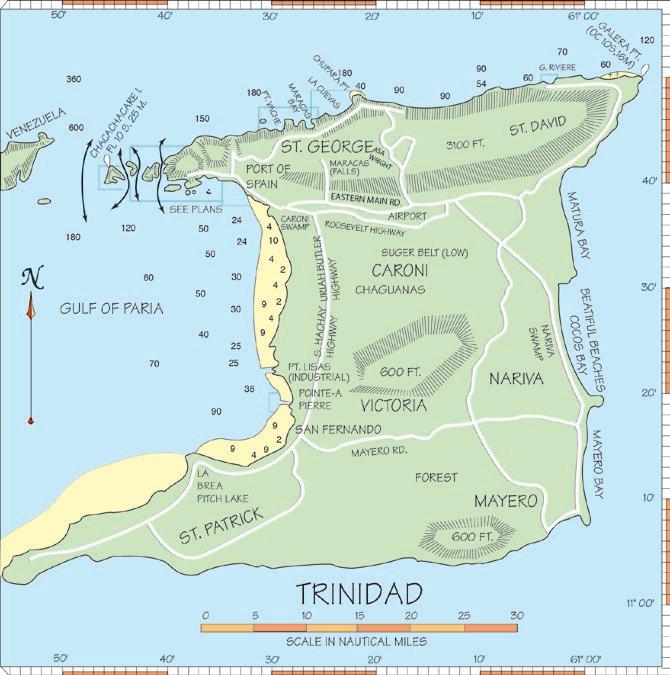
There are a good number of Trinidadian yachtspeople and they have an active yacht club, the Trinidad and Tobago Sailing Association (TTSA). They are particularly welcoming and friendly to visiting yachtspeople and members love to see everyone have a good time. There is also the Trinidad and Tobago Yacht Club (TTYC), though these days it is more motor-yacht focused.
Trinidad also has several out-of-the-way anchorages. These make perfect getaways for a few days of peace and quiet. Many of these offer great hiking for the adventurous. This is particularly true of the north coast bays, though getting ashore in any kind of swell can be tricky.
Doyle Guides contain the Eastern Caribbean’s most comprehensive and reliable sailing information, available in hard copy and online through a free mobile app, website, and Facebook group. (www.doyleguides.com).
St George’s Grenada Call 1 (473) 444 3944 macford@spiceisle.com



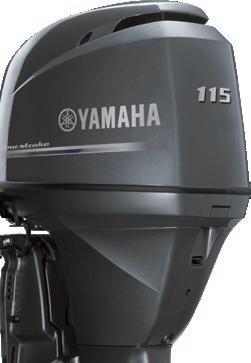


Ports of Entry:
There is one port of entry in Trinidad - Chaguaramas [ https://www. noonsite.com/place/trinidad-tobago/trinidad/chaguaramas/] and two in Tobago - Scarborough [ https://www.noonsite.com/place/trinidadtobago/tobago/trinidad-tobago-scarborough/ ] in the south or Charlotteville [ https://www.noonsite.com/place/trinidad-tobago/ tobago/charlotteville/ ] in the north.
Advance Paperwork:
All yachts are expected to file a Float Plan to notify authorities of their pending arrival. Most crew are granted a visa-waiver 3-month stay on arrival. An import permit should be arranged in advance for any pets on board.
Entry Process:
After being cleared by Port Health, crew can proceed to Customs & Immigration (who will want to see all crew members). Expect more paperwork than in other Caribbean islands. When moving between ports, yachts must check in/out with Customs & Immigration.
Exit Process:
Clear-out with Customs, Immigration and the Port Authority. Immigration grant yachts up to 4 hours to depart (24 hours if clearing domestically). If departing for Grenada, it is possible to file a passage plan with the Coast Guard.
Rates:
Arrival fees include Immigration and Port Authority charges. Departure fees include a departure tax (if more than 2 crew on board) and navigation fees (based on time spent in country). Overtime fees are payable outside of normal operating hours.
Approximate clearance costs for a double-handed yacht staying up to 30 days (excluding overtime charges) is TT$900 (US$133). All fees are paid in cash (local TT$).
Check https://www.noonsite.com/place/montserrat/view/clearance/ for more detailed information and updates.

This information is provided by Noonsite.com, specialists in worldwide formalities for yachts, and was accurate at press time.
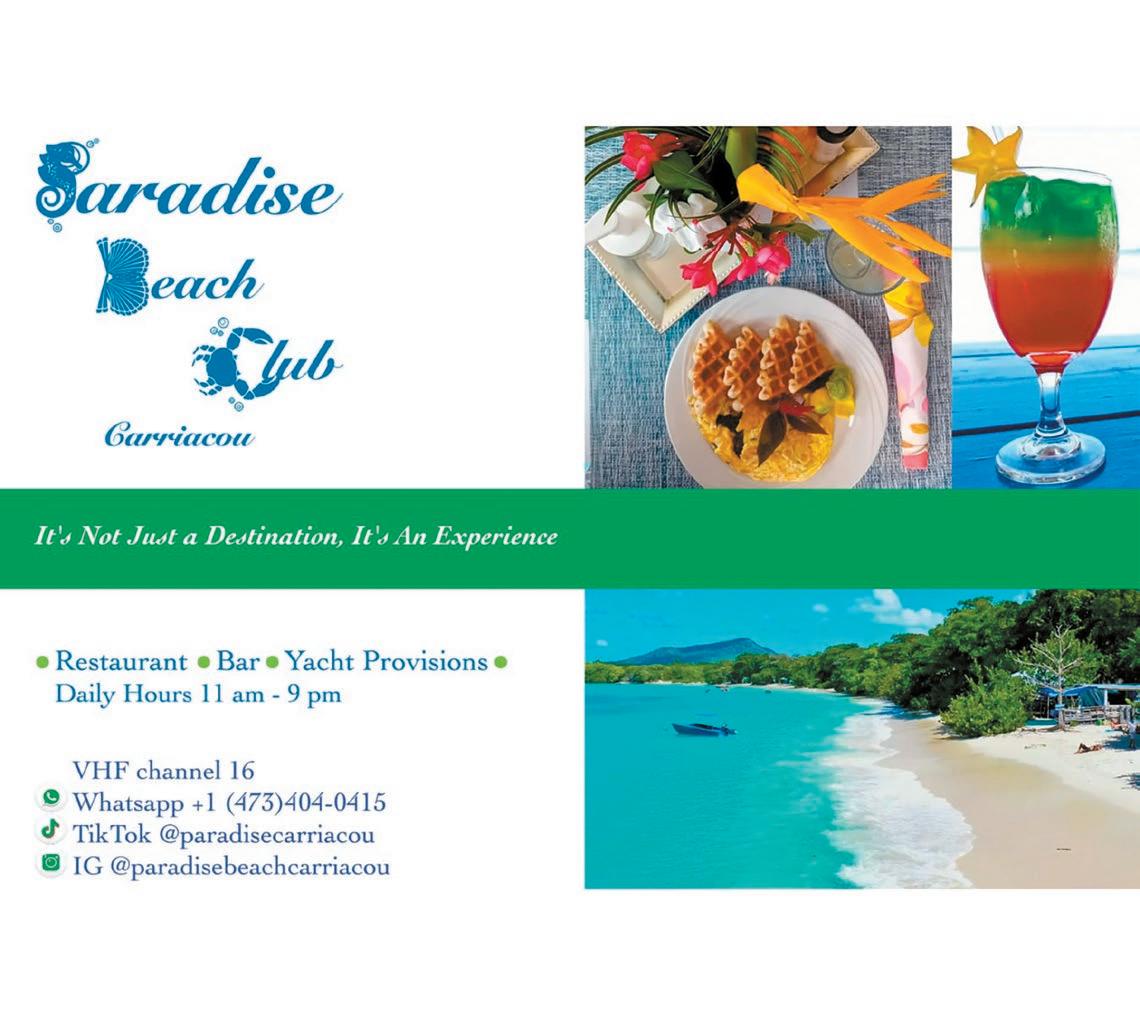
PT-9900-144 HORTA / FAIAL, AZORES
Providing all vital services to Trans-Atlantic Yachts!
Incl. Chandlery, Charts, Pilots, Rigging EU-VAT (16%) importation
TEL +351 292 391616
Junes@mail.telepac.pt www.midatlanticyachtservices.com



Check out our website or contact us directly for a competitive quote on rugged and well-built sails that are well suited to the harsh environment of the charter trade and blue water cruising.
Jeff Fisher – Grenada (473) 407 6355 www.neilprydesails.com



closed until mid october
Beautiful Carriacou, Grenadines is building back bigger and better. Now is the time to INVEST in the best of Carriacou Real Estate.
Seeking investor- managing partner for exclusive eco-centric beachfront bar adjacent to gorgeous Sandy Island coral reef marine park.
Seeking JV real estate development investors for exclusive eco-luxury villa residentialresort communities overlooking Tyrell Bay & Marina.

Contact: GrenadinesRealEstate@gmail. com for more information Serious Enquires Only Please



NEW SAILS, SAIL REPAIRS, U/V COVERS BIMINI, DODGERS, AWNINGS, DINGHY COVERS, UPHOLSTERY TRAMPOLINES, STACKPACKS & LAZY JACK SYSTEMS
FOR MAJOR PROJECTS, REQUIRING 3 OR MORE DAYS, PLEASE CONTACT US AT LEAST 2 WEEKS IN ADVANCE.
BEST CUSTOM-MADE DINGHY CHAPS
Located northern side of Admiralty Bay Tel 1.784.530.7784 or 1.784.593.0723 (whatsapp) gsailsbequia@gmail.com




